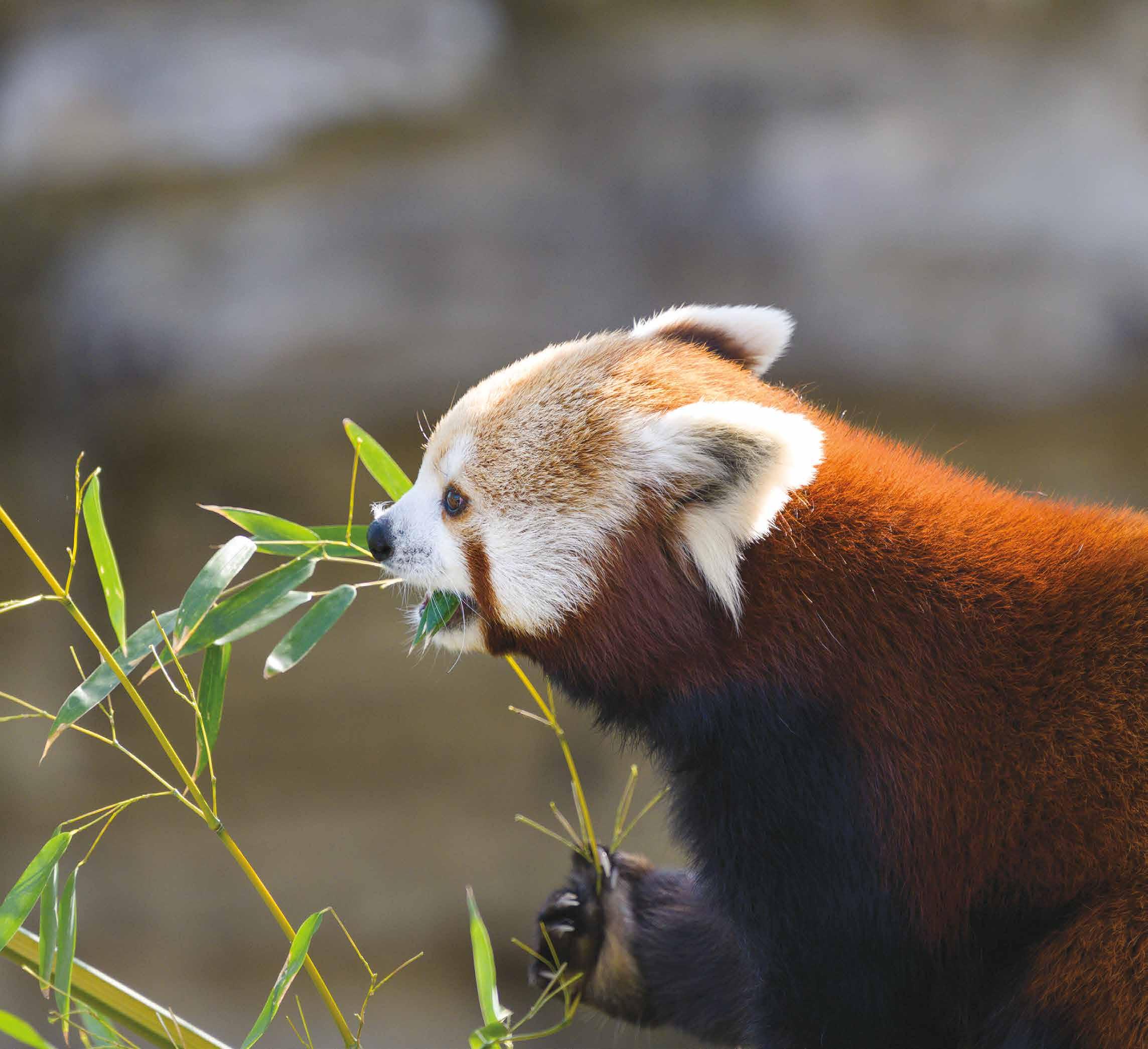Summer 2022
Volume 38,
 A Tale of Two Red Pandas | Building a Foundation for Next-Generation Conservationists | Restoring a Beloved Attraction
A Tale of Two Red Pandas | Building a Foundation for Next-Generation Conservationists | Restoring a Beloved Attraction

 A Tale of Two Red Pandas | Building a Foundation for Next-Generation Conservationists | Restoring a Beloved Attraction
A Tale of Two Red Pandas | Building a Foundation for Next-Generation Conservationists | Restoring a Beloved Attraction
A summer in St. Louis isn’t complete without a visit to the Saint Louis Zoo. Our extended hours on Fridays and Saturdays are great opportunities to enjoy the Zoo on cooler mornings and evenings. These extended hours run through August 14, so be sure to enjoy this special time before summer draws to a close.
Guess who else loves the cooler mornings? The red pandas. These small, fuzzy animals are close to many people’s hearts, and you can find them at the heart of the Saint Louis Zoo in Schnuck Family Plaza. In this issue’s cover story, learn all about red pandas Winnie and Pete from Carnivore Keeper Mary Witucki, one of their caretakers. You’ll read about how you can tell them apart, their favorite treats, and all the dedication and hard work that goes into caring for these two intelligent animals.
Although we’re still enjoying the summer season and it’s not time to think about going back to school yet, we wanted to highlight the important role that educators play in shaping young minds. At the Zoo, our educators work all year long to connect children to animals and encourage them to make a positive difference for the planet. In the article on page 12, learn about how our educators utilize our Zoo as a classroom and discuss age-appropriate conservation subjects. You also can read some tips about how you can help your child develop an appreciation for nature.
Around and around we go ... the Mary Ann Lee Conservation Carousel is beloved by many. After nearly 20 years of happy merry-go-round rides, the hand-carved wooden animals needed a little restoration. On page 18, read about the team members who have meticulously repaired and provided new paint to our wooden carousel animals, making them look brand new and ready for future generations.
Our educators do so much good work at the Saint Louis Zoo, and our education programs go far beyond our 90-acre campus. Several of our educators also host programs as a part of the Saint Louis Zoo WildCare Institute, the conservation arm of the Saint Louis Zoo. From Forest Park to Saipan to Alaska, read stories from three of our educators on page 20 about how they connect children in all different parts of the world to animals and conservation.
There’s a lot of summer fun left on the calendar. If you’re looking for a relaxing adults-only evening at the Zoo, check out Night at the Zoo presented by Mercy on July 27. Or, if you’d like an energizing night with beer and wine tastings, Jammin’ at the Zoo is on August 24 — back after a two-year hiatus! And Jungle Boogie presented by Mid America Chevy Dealers continues every Friday night through August 12 — a perfect summer evening out with the family.
I hope you enjoy this issue of stlzoo magazine, and thank you for supporting the Saint Louis Zoo.
COMMISSION OF THE ST. LOUIS ZOOLOGICAL PARK SUBDISTRICT
Chair
Cynthia J. Brinkley
Vice-Chair Lawrence E. Thomas
Co-Treasurers Chonda J. Nwamu Lawrence E. Thomas
Immediate Past Chair Winthrop B. Reed III
Commissioners Karl A. Grice
Robert R. Hermann, Jr. Jerald L. Kent
Robert F. O’Loughlin Neal F. Perryman
Michael W. Riney Peggy A. Ritter Steven C. Roberts
Will R. Ross, MD, MPH Carol A. Wilson
Chairs Emeritus Honorable James F. Conway Steven F. Schankman Mark J. Schnuck
President Alicia S. McDonnell
Vice President Robert B. Smith III
Treasurer James E. Williams, Jr. Secretary Michael J. Hickey
Immediate Past President John R. Sondag

Executive Committee
Caryl L. Flannery
Pamela A. Glaser
Charles Henson
Mark W. Hubbert
Linda J. Hunter
Molly Hyland
Kenneth A. Johnson Dr. Matthew R. MacEwan
Melissa Markwort
Jennifer T. McGrath
Lisa W. Nouss
Thomas P. Pollihan
Angela D. Schaefer
William R. Schmidt Heather Wood
Susan S. Block Cenia D. Bosman
Christine Boushka Dr. Edmond B. Cabbabe
Mary B. Campbell
Debbie A. Caplin
Karen L. Condie
Hazel Alethea R. Donald Edward Durham Brad M. Edwards
Cory Elliott
Kathy S. Federico
Logan W. Finerty
Lauren Thomas Fries Matthew W. Geekie Amy A. Gill Brett G. Gilliland
Janis G. Goldstein
Kenneth H. Hannah
David P. Hatfield
Ricky L. Hopkins, Sr. Ryan L. Hyman
Robert F. Johnston
Carol S. Klein
Lee C. Kling
Judith B. Kouchoukos
James P. Leonard
Davida Lichtenstein
Julie Lilly
Sarah London Dr. Dan W. Luedke
Ryan J. Martin
Anna McKelvey
John F. Meara
Julia Mize
Patrick J. Moore
Dr. Stanley J. Niemann Bhavik R. Patel Pravina Pindoria Dr. Steven S. Pope Dana Tucker Redwing Stephen M. Reese Quirsis V. Riney James G. Sansone Steven F. Schankman
Shelley Seifert Ashish Sinha Torbjorn B. Sjogren Lisa K. Sullivan Dianne Sutcliffe
Kevin Travers
Virgil Van Trease
Lottie Wade Matthew A. Wagner Gerald E. Wiley Robert M. Williams, Jr.
Emerita – Emeritus Members
James G. Berges
Marguerite Garrick Douglas E. Hill
Joseph F. Imbs III John K. Wallace, Jr.
Ex-Officio Katie Lineberry
Treasurer Brittany Mayfield Liaisons Meghan Haines Jennifer Jeffries Rei Kato Tre Moore Rob Patterson Mike Poletti Phil Posley Zach Ungerott Eric Werner
6A Tale of Two Red Pandas
Red pandas Winnie and Pete are among guests’ favorite animals. Learn all about them from one of their keepers.

Building a Foundation for Next-Generation Conservationists
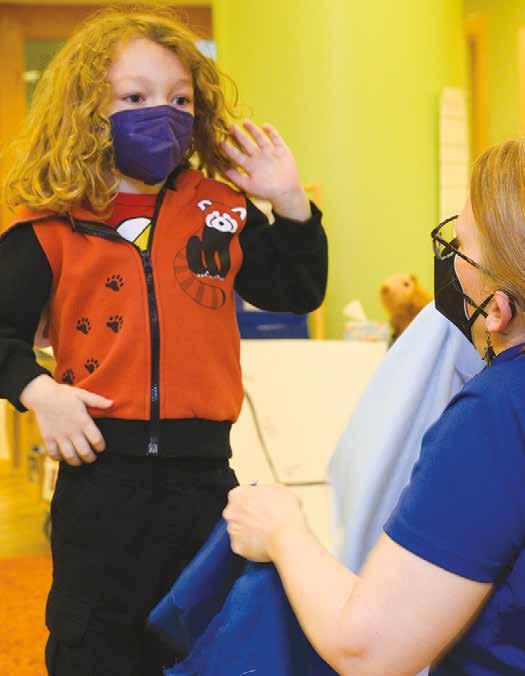
Zoo educators work yearround to connect people to animals and nature. Read about how they help shape the minds of our youngest guests.
Restoring a Beloved Attraction: The Mary Ann Lee Conservation Carousel

Meet the team who is working to make our wooden carousel animals look brand new!
On the Cover Red panda

Photo by Ray Meibaum
Paper kite butterfly
stlzoo is published quarterly as a member benefit by the Saint Louis Zoo Association, One Government Drive, St. Louis, MO 63110. Permission to reprint any material is granted, provided proper credit is given.
n Managing Editor: Rebecca McMiller
n Editorial Assistance: Billy Brennan, Jill Gordon, Kirby Meyer, Elaine Vydra
n Graphic Design: McCord Design Group
n Contributing Photographer: Ray Meibaum
n Contributors: Members of the Zoo staff
At the Saint Louis Zoo, we not only care about the conservation of animals, but also about the conservation of the environment. That is why stlzoo magazine is created using FSC- (Forest Stewardship Council) certified paper with recycled materials and eco-friendly inks.
I’m sure many of you have already visited the Zoo this year, and summer offers many opportunities to come back again and again. Your member benefits are an even greater incentive. They include member tickets to our most popular attractions and a 10% discount on food purchases and in gift shops. You’re also entitled to free parking (based on availability). Please remember to bring your membership card when visiting the Zoo so you can take full advantage of your benefits.
Emerson Dinoroarus, which first opened in 2021 with a members-only preview, has reopened for the season and there are many new features to enjoy. A new dinosaur, the Euoplocephalus, has joined the collection of prehistoric pals. There also are several new hands-on opportunities, including the Dino Dig and Dino Play areas. Your member tickets make it hassle-free to explore Dinoroarus like a real paleontologist!
If you’re planning to travel this summer, consider visiting another zoo! The Saint Louis Zoo partners with other Association of Zoos & Aquariums (AZA) organizations to provide a list of over 100 reciprocal partners. As a Zoo member, you receive free or discounted admission to other AZA organizations that participate in the AZA Reciprocal Admissions Program. Please visit our website for the AZA reciprocal partner listing.
Stay informed about animal births, events and Zoo news with email newsletters. If you would like to receive member emails, please call (314) 646-4771, option 2. You also may send us an email with your membership number and email address to membership@stlzoo.org. n
Please bring your membership card with you on each visit to the Zoo to enjoy your free parking and attraction benefits. Please note: If you visit without your card, you may retrieve your member tickets at either Welcome Desk but not at the various attraction locations.
By Katie Lineberry, President, Zoo Young Professionals Advisory BoardThe weather is warmer, and many of us are feeling more comfortable attending events and venturing out more. I’m so happy the Zoo is one of the places we have been able to enjoy year-round. Of course, summer is the most popular time to visit the Zoo, and this year is no exception. There are many events taking place that you’ll want to add to your calendar.
Our adults-only events, Night at the Zoo presented by Mercy and Jammin’ at the Zoo, will take place on select Wednesdays throughout the summer. We’re so glad Jammin’ is back, and I am looking forward to seeing you. Invite your friends and encourage them to become Zoo Young Professionals (ZYP) members, too! As a reminder, you can use your free tickets for admission to either event. Details
about these and other ZYP-focused events will be sent via email, and you can check the website for event dates and details. And don’t forget about Jungle Boogie presented by Mid America Chevy Dealers. This free concert series takes place every Friday evening through August 12.
We’re passionate about supporting animals and the conservation work that takes place at the Zoo as well as around the world. And we like to have fun doing it! Your membership supports the mission of the Zoo. Thank you!
If you are interested in receiving invitations to ZYP events and you are a member at any other level, just send an email to membership@stlzoo.org to let us know. We hope to see you at the Zoo this summer. n
Fridays, 4–7 p.m., May 13–August 12
It’s time to perk up your summer fun with our free, family-friendly concert series. Jungle Boogie features a wide array of musical genres and some of St. Louis’ most entertaining bands. As always, yummy food and thirst-quenching drinks will be available for purchase. Also, come enjoy cooler evenings at the Zoo during Prairie Farms Dairy Summer Zoo Weekends on Fridays and Saturdays until 7 p.m. all summer long.
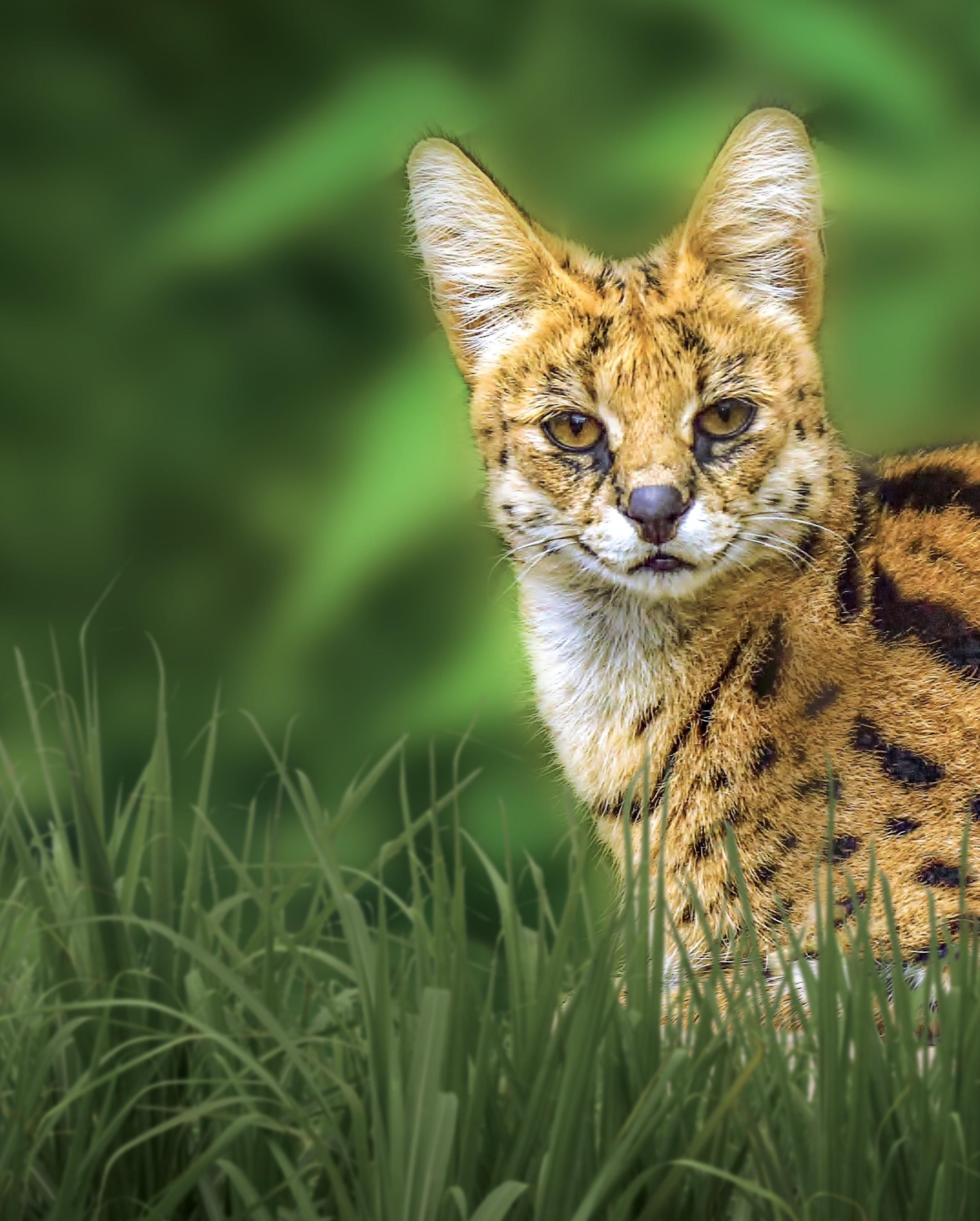


These are different from the kinds of treats you eat. For a carnivore like a bear or tiger, this special treat may include water or blood, plus chunks of meat or produce (like lettuce and carrots). Animals may receive plain ice blocks, too.
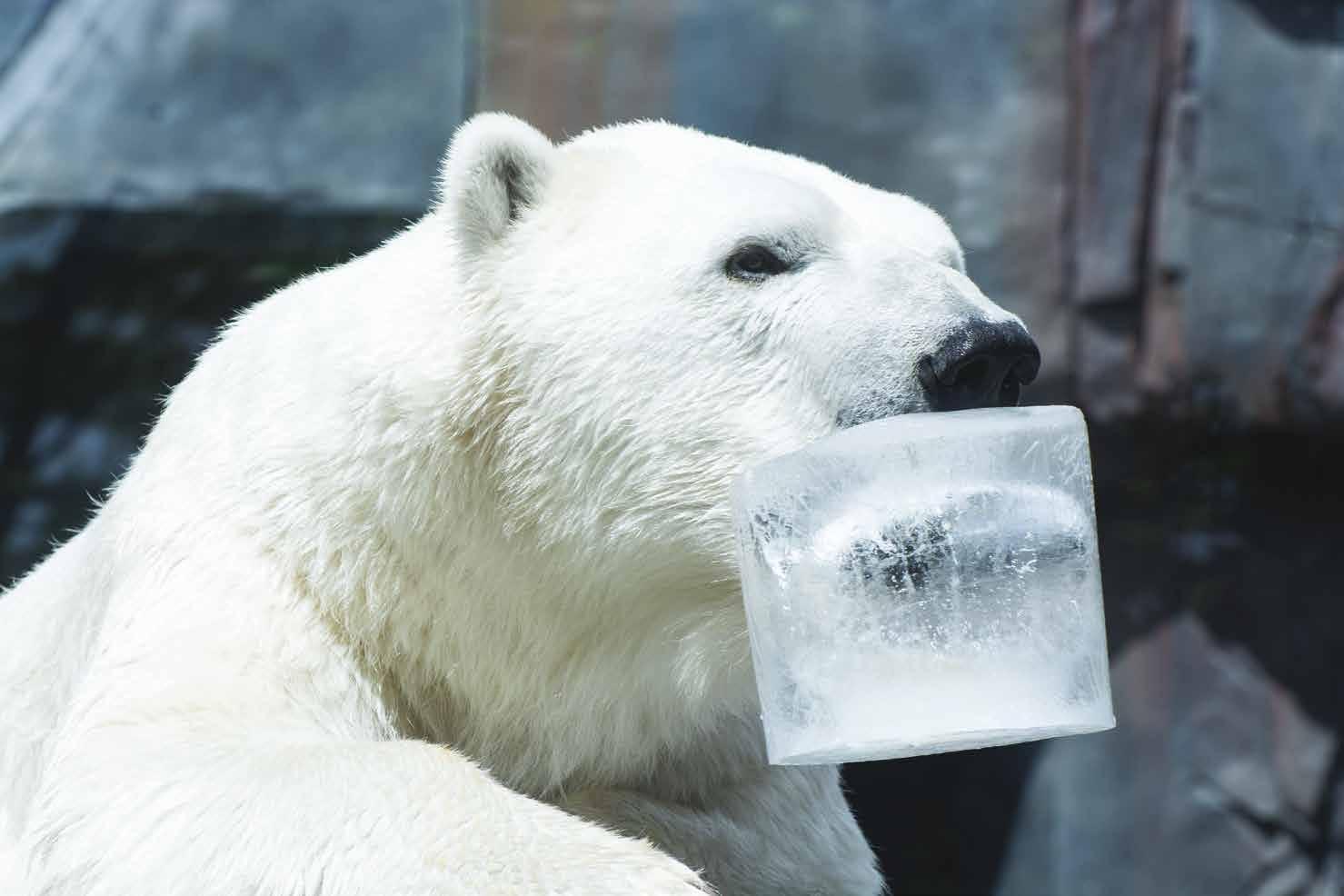
When it gets too hot outside, certain animals must be brought to their indoor habitats or private, air-conditioned areas. For example, if it’s a 100-degree day, you’ll likely find the orangutans, gorillas and chimpanzees at Jungle of the Apes (their indoor habitat) rather than the Donn and Marilyn Lipton Fragile Forest (their outdoor habitat).
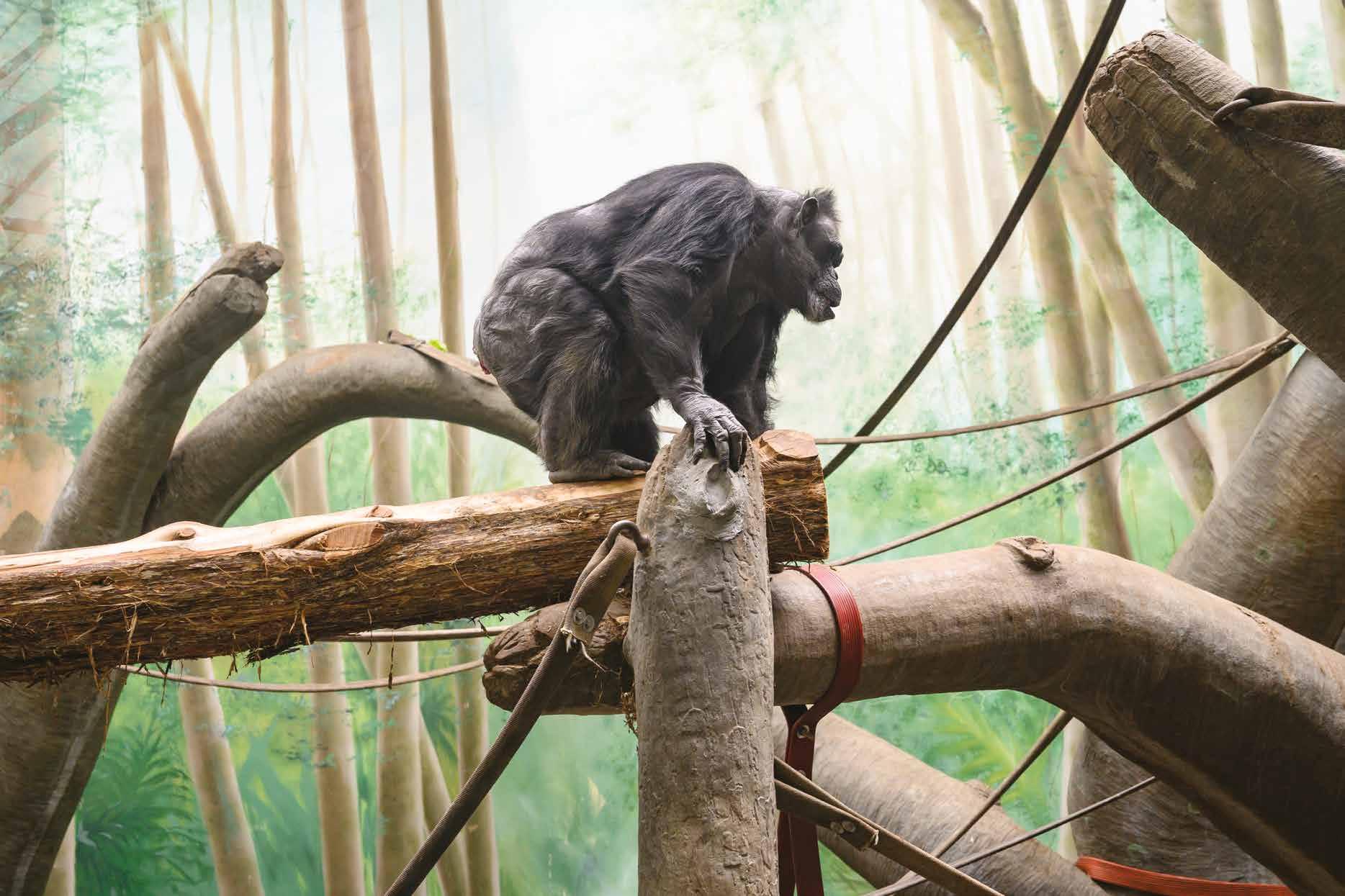
LEARN MORE about how we care for animals by following us on social media or visiting
Right at the heart of the Saint Louis Zoo live our two red pandas, Pete and Winnie. Pete is our 10-year-old male red panda and has lived here since 2014. Winnie, the new girl in town, is our 7-year-old female red panda who came to us in the winter of 2021. Both Pete and Winnie were born in the month of June, just one day apart from one another!
The red pandas are a guest favorite, and I can assure you that the feeling is mutual among their keeper staff. What they lack in size, they make up for in personality! Both pandas are very intelligent and highly food motivated. They also enjoy spending time with keeper staff, foraging on fluffy bamboo or participating in training sessions with their keepers. Some of their favorite treats are blueberries, grapes, apples and pears. Pete tends to be more active during the day, spending his time exploring and scent marking. He can sometimes be warier of new things, while Winnie is more investigative. In the short time that we have known her, she has been very curious of new items and new places to climb in her habitat.
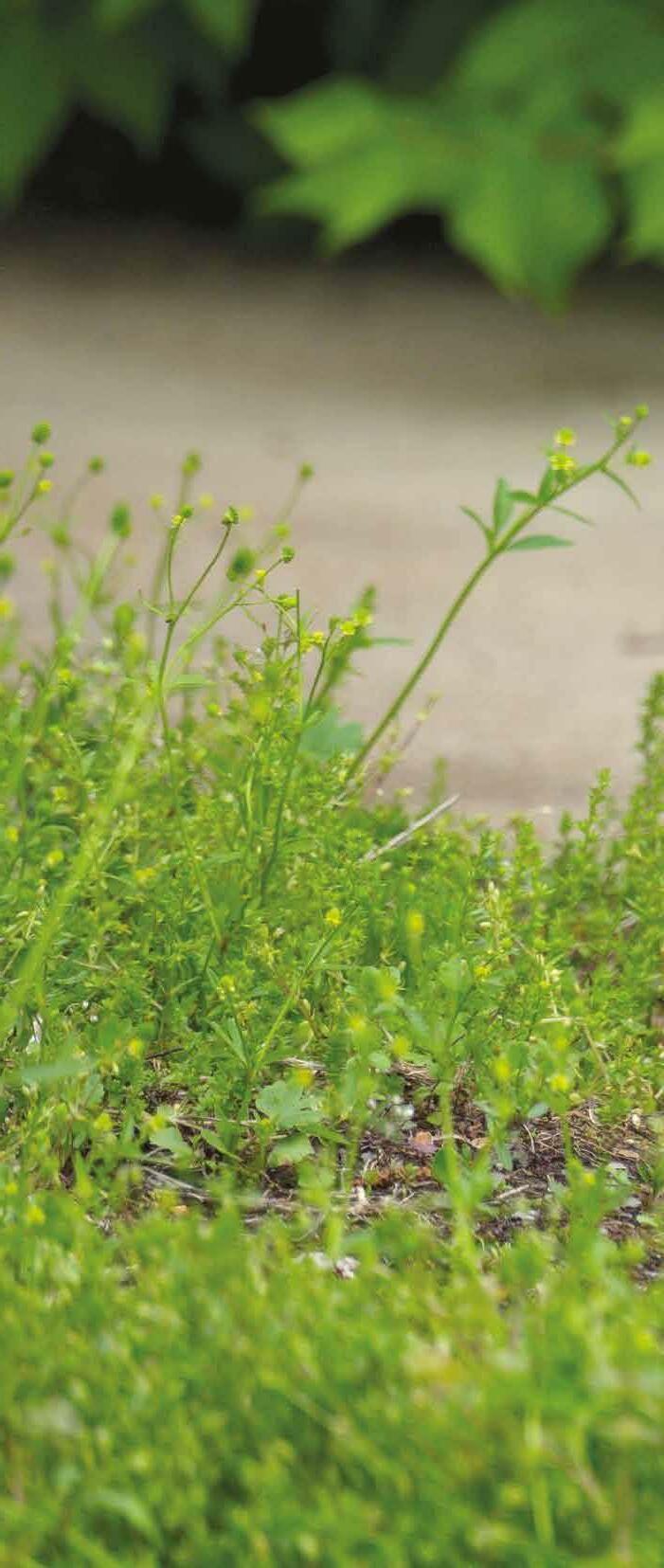


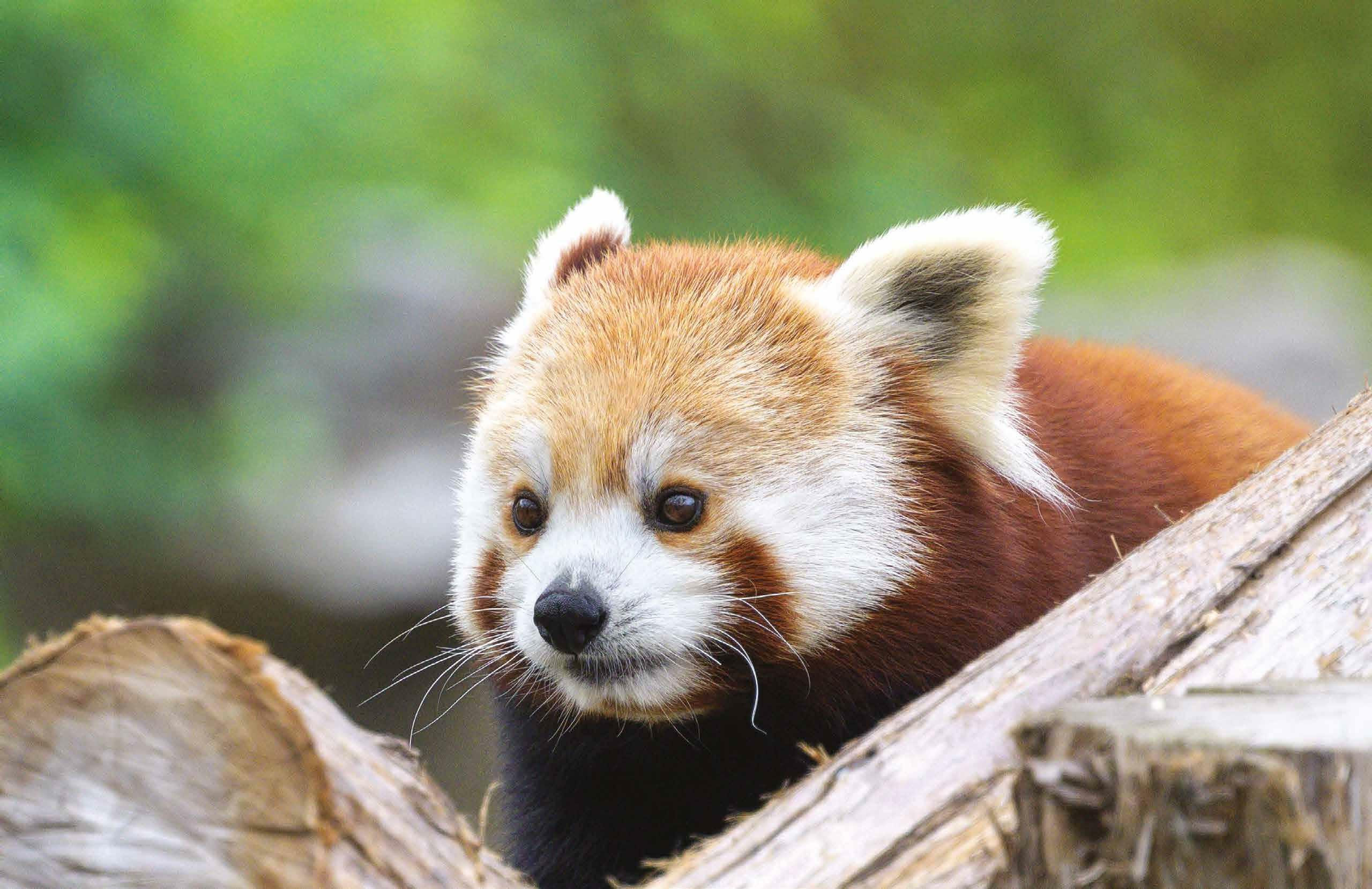



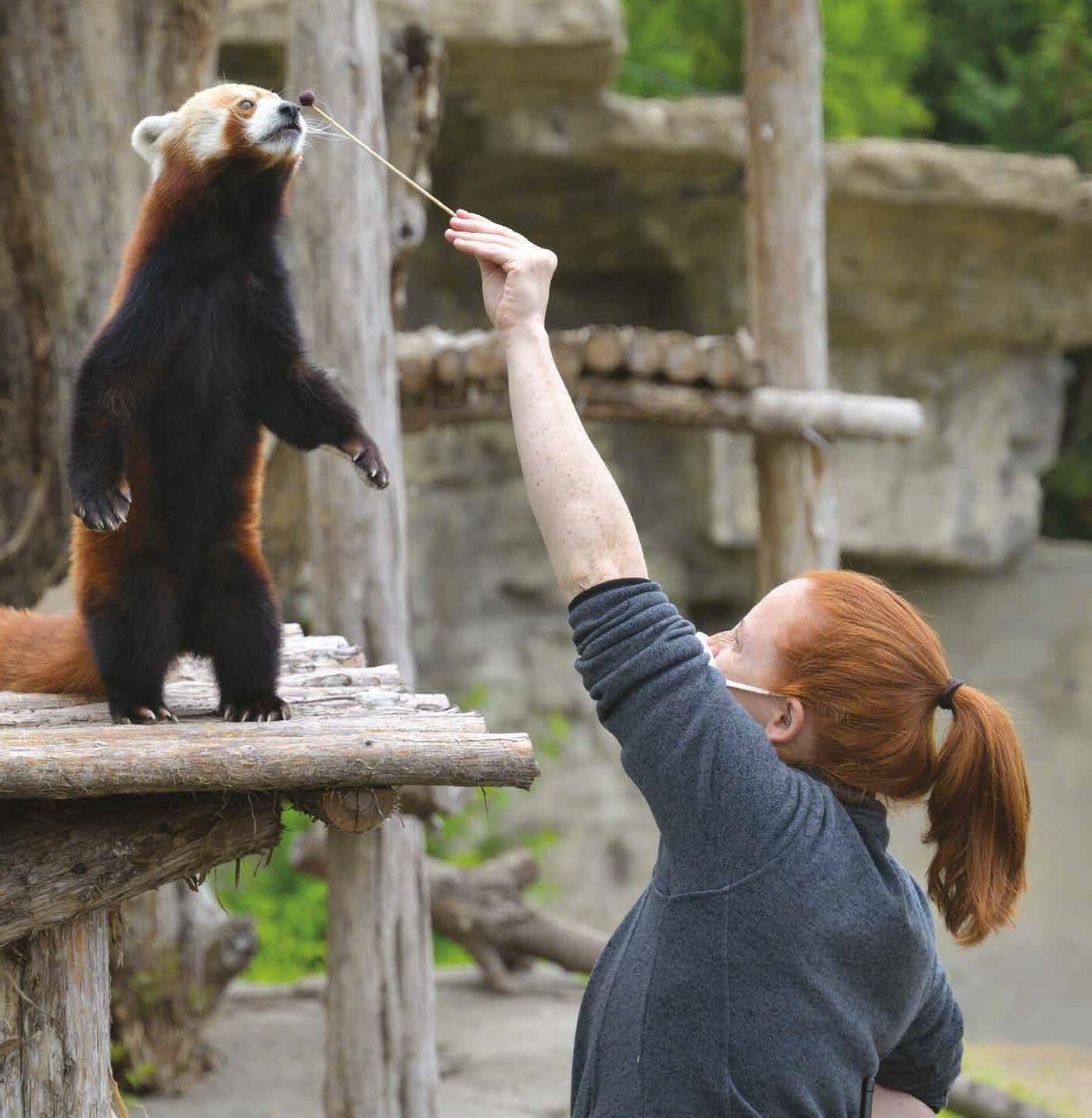
Telling them apart can be a little tricky when you do not see them side by side. What we look for are the primary differences in their faces and body shape. Winnie is slightly larger than Pete and has a lighter forehead. Red pandas have distinct markings that are normally a shade of red, located from their eyes to the bottom of their chin, known as “tear marks.” Winnie’s tear marks start just below her eyes but do not fully connect up to them. She also has a tuft of white fur on the tip of her nose, which we find absolutely adorable. Pete has a very dark face and forehead, along with dark tear marks under his eyes.
Being a red panda keeper comes with a variety of responsibilities. We are tasked with taking care of the red pandas’ daily needs. This can be anything from cleaning their habitat and indoor bedrooms to monitoring their daily health and wellness. One of the most important duties that keepers are responsible for is harvesting their bamboo. The red panda diet is made up of over 90% bamboo … that’s a lot of greens! They also eat two types of formulated chow daily (similar to dog or cat kibble) as well as a variety of fruits to give them extra nutrients that they do not receive from the bamboo alone. While walking around the Zoo, I am sure you have noticed many locations where bamboo grows. This allows us to have many bamboo options to feed our red pandas.
One other very important task that keepers are responsible for is monitoring their daily behavior. Subtle changes in their behavior
can tell us things about their environment, food or health. Red pandas are solitary animals in the wild, but it is very common for two individuals to live together in zoos. Winnie was recommended to come to the Saint Louis Zoo by the Red Panda Species Survival Plan. Before introducing Pete and Winnie physically together, we started introductions through the use of a “howdy door.” Using a “howdy door” allows for both pandas to be able to see, sniff and communicate with one another before being in the same space at the same time. This type of introduction is often the first step when introducing two animals that do not know each other. This time allowed for Winnie to become familiar and confident with her new surroundings, keeper staff and home. Winnie was able to explore her indoor bedrooms as well as the habitat by herself during the daytime and overnight. As Winnie showed confidence in her new environment, we also started noticing behaviors that indicated to us that both pandas were interested in one another. Some of these behaviors included smelling, watching and vocalizing at one another. At the end of the “howdy” introductions, we were observing all positive behavior among both Pete and Winnie, indicating that we could proceed in introducing them together. These physical introductions inside, as well as outside on the habitat, all went great! They are currently together 24/7 and can be seen out on habitat coexisting peacefully.
Pete is a 10-year-old male, and Winnie is a 7-year-old female.
They are intelligent and highly food motivated.
In addition to bamboo, their favorite treats are blueberries, grapes, apples and pears.
Winnie is slightly larger than Pete and has a lighter forehead. All animals at the Zoo are given choices on how they want to spend their days. During the summer, Winnie and Pete are typically most active first thing in the morning when it is the coolest. During midday and afternoons, they often choose to rest in their treehouse or in their temperaturecontrolled indoor bedrooms. Late fall and winter also are great times to see them!
Cleaning the habitat and indoor bedrooms.
Monitoring their daily health and wellness.
Harvesting bamboo and providing a nutritious diet.
Monitoring daily behavior.
Providing enrichment, which may include toys, scents or different food items.
Updating the habitat with new items for the animals to explore, such as new substrates or logs.
Providing positive reinforcement training and target training to encourage animals to participate in their own health care (such as opening a mouth or presenting a paw for inspection).
Enrichment is another important aspect of our job as keepers! Enrichment provides our red pandas with challenges, environmental stimulation, and physical and mental exercise. These activities may include toys, scents, different food items or anything else that is designed to elicit their natural behaviors. We can hide grapes in hanging puzzle feeders or scatter them throughout their habitat for them to find. We will also place bamboo at different heights and locations daily, which encourages them to utilize all areas of their habitat. Throughout the year, we will bring in new substrates (such as straw or wood chips) or brand-new logs to create different perching options in their environment as well. Winnie and Pete are pretty curious pandas, and they love to explore and interact with new things!
Training also is crucially important in animal care. Here at the Zoo, keepers utilize positive reinforcement training with our animals for multiple purposes such as medical care, general health, mental and physical stimulation, and relationship building. Pete and Winnie are very eager participants during these training sessions. Both pandas will voluntarily step onto a scale in order for us to weigh them weekly. They also received their COVID-19 vaccine late last year, and both received it voluntarily. Winnie is currently working on following a target around and learning to walk into a crate. Target training is important because it allows us to
position their bodies in a way that enables us to look them over closely. Pete is a seasoned pro and has learned to follow a target and stand up straight on his back legs. This allows us to be able to see his neck and belly easily, parts of his body that we are not able to see when he is climbing. Pete also will present his paws on the fence so keepers can examine his paw pads and nails to make sure they are clean and clear of cuts or scrapes.
When is the best time to visit our red pandas? Pete and Winnie tend to be more active and explore first thing in the mornings, around breakfast time. In the middle of the day or afternoons, you can often observe them resting. Here’s a hint: Pete’s preferred resting spot is up in the treehouse, so you usually have to step back to see him curled up! Red pandas’ bodies are built to withstand cold temperatures, so late fall and winter also are two great times of the year to see them! During the summer, your best chance to see them is in the morning, when it is coolest outside. Once it reaches a certain temperature during the summer, they have access to their temperature-controlled indoor bedrooms. We also have a mounted fan and mister outside to help cool them off during the summer.
If you happen to see a keeper in the red panda area, ask them all of the questions you have! We hope you come say hello to Pete and Winnie on your next Zoo visit! n
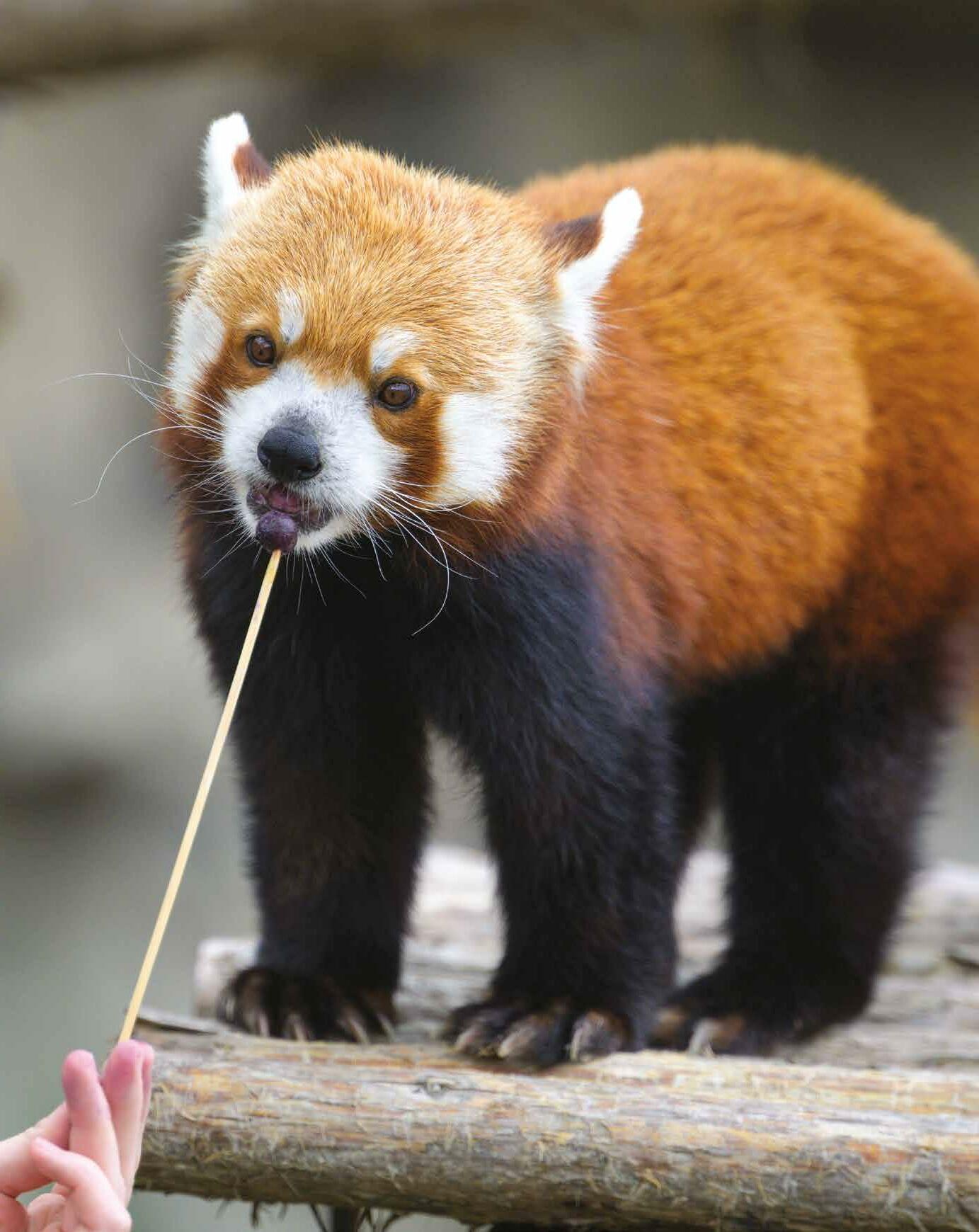
Become a Zoo Parent and adopt a red panda! No, you can’t physically take a red panda home, but your adoption supports our animals’ feeding for a whole year! Your adoption package includes a certificate of adoption, invitation to the Zoo Parents Picnic and more. Visit stlzoo.org/adopt for more about all adoptable animals.

 By Rebecca McMiller, Marketing Communications Manager Photos by Kari Frey and Ray Meibaum
By Rebecca McMiller, Marketing Communications Manager Photos by Kari Frey and Ray Meibaum
All of us remember at least one educator who impacted our lives. Mentors play a crucial role in inspiring kids to care about the planet; a poll among top conservationists indicated they collectively had a nurturing adult who inspired their love of the natural world. The importance of educators cannot be overstated. At the Saint Louis Zoo, we have a team of educators who connect people to animals, encourage curiosity and questions, and empower people to take action to make our planet a better place.
mentors play a crucial role in inspiring kids to care about the planet
”
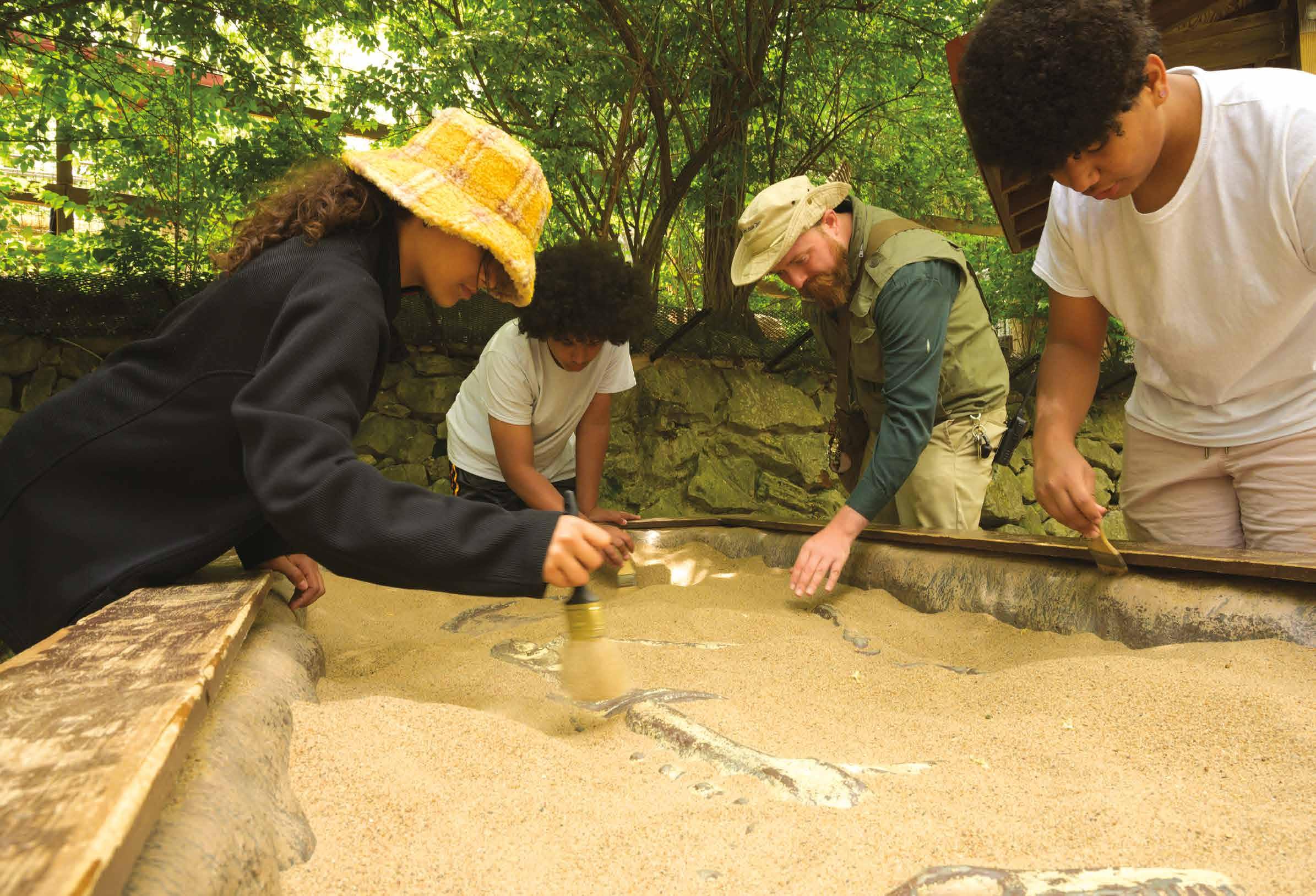
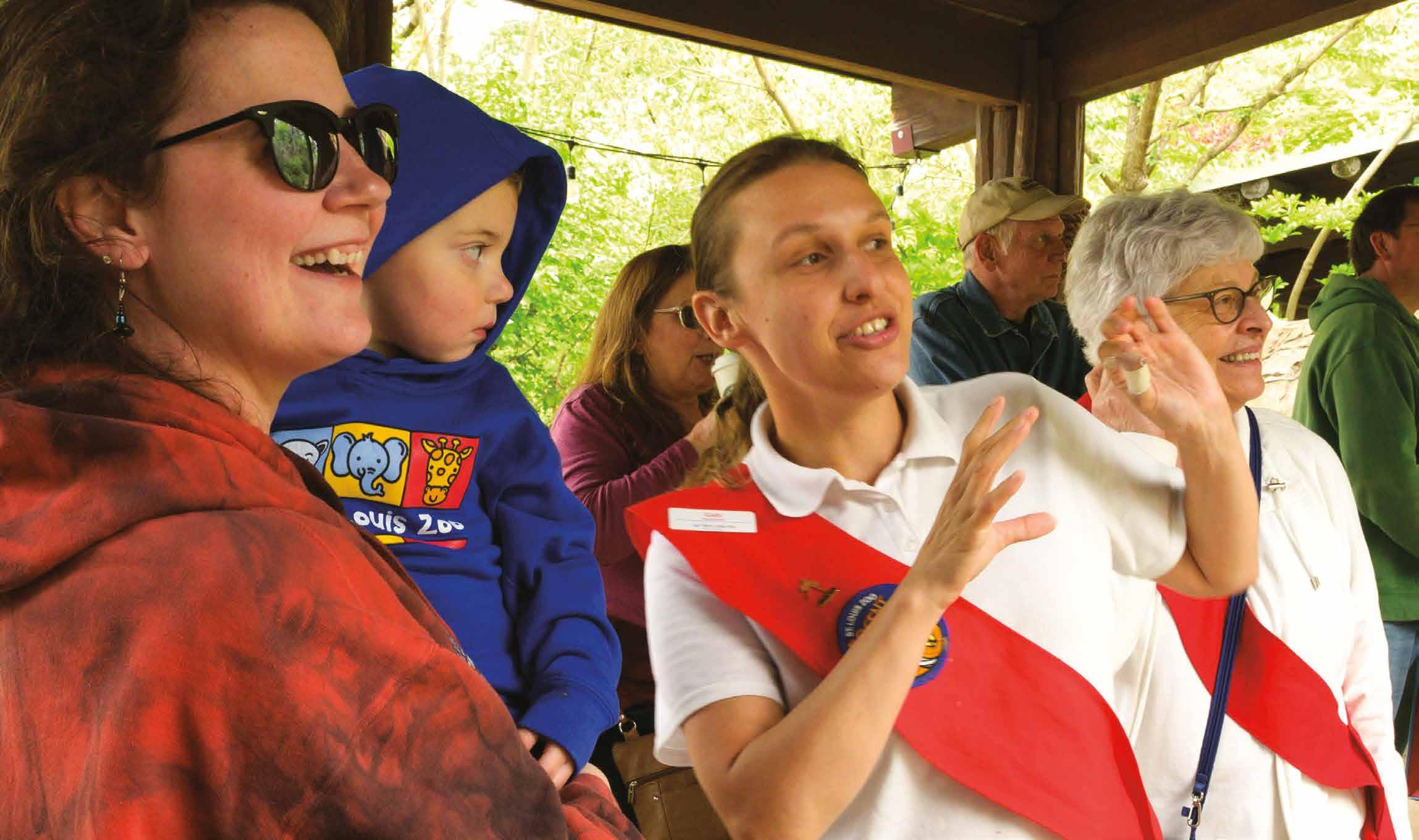

At the Saint Louis Zoo, learning happens every day. Educators connect with students in the Zoo Preschool and K-12 audiences around the world, host programs and camps, and interact with guests during their Zoo visits. A core value among Zoo educators is the benefit of spending consistent time in nature, especially for kids.
“There are many key life skills that children can develop while outside,” said Laura Seger, Manager of Learning Experiences and Director of Zoo Preschool. “They develop resilience and risk assessment skills in a safe way for example, ‘can I climb this big hill?’ Time in nature also supports problem solving, self-esteem and relationships with others.”
At Zoo Preschool, classes spend at least 50% of the day outside. Even when indoors, students are surrounded by natural elements. “In our indoor classroom, we may paint with seed pods or build musical instruments with sticks,” Seger said. “Our preschool is based on nature-based learning, which encourages not just exposure to the outdoors, but for nature to be brought into built environments as well.”
The Saint Louis Zoo could be considered the ultimate classroom … 90 acres of nature to explore! Even during a regular Zoo visit, you may find educators just waiting to talk to you. Hannah Phillips, Manager of Docents and
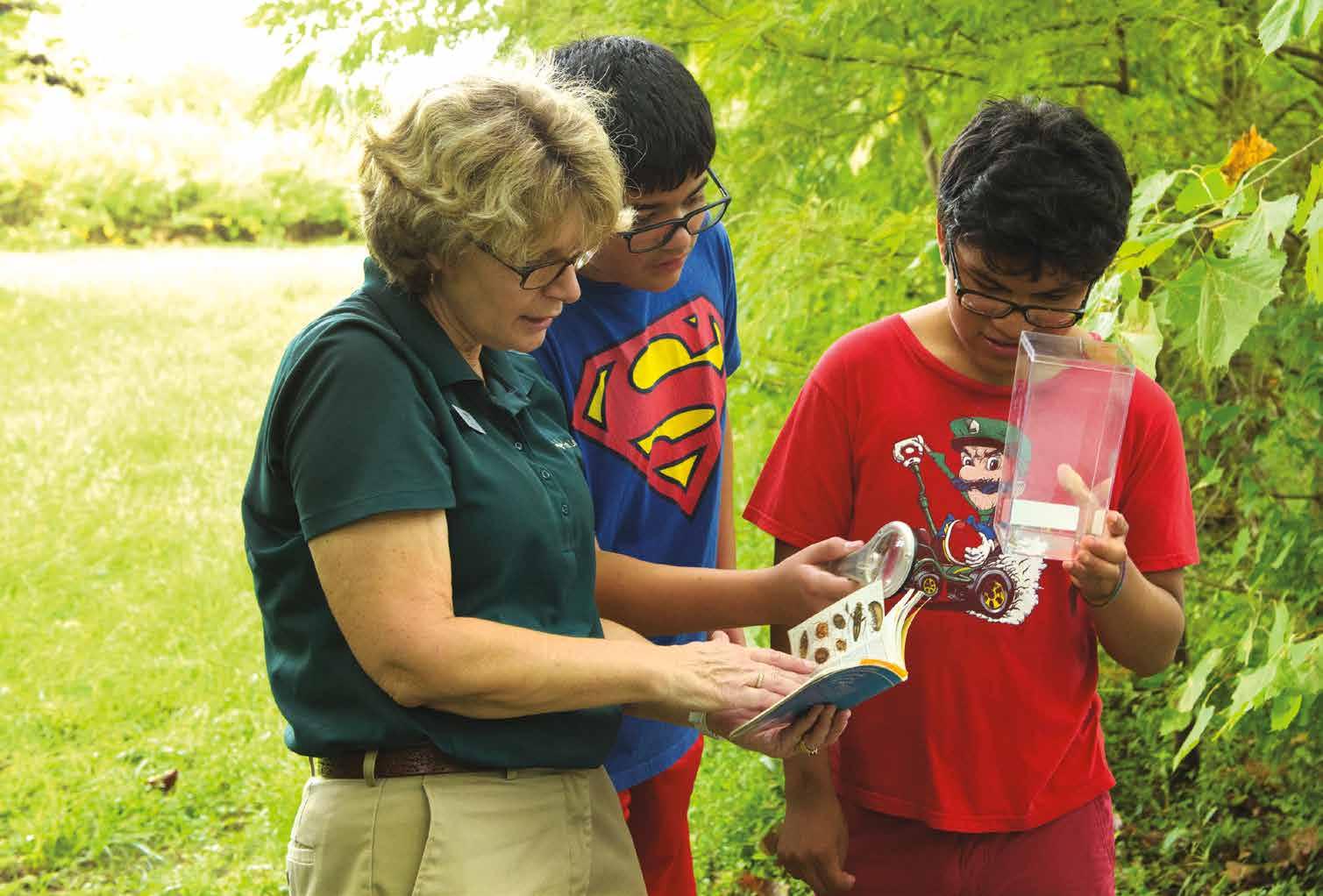
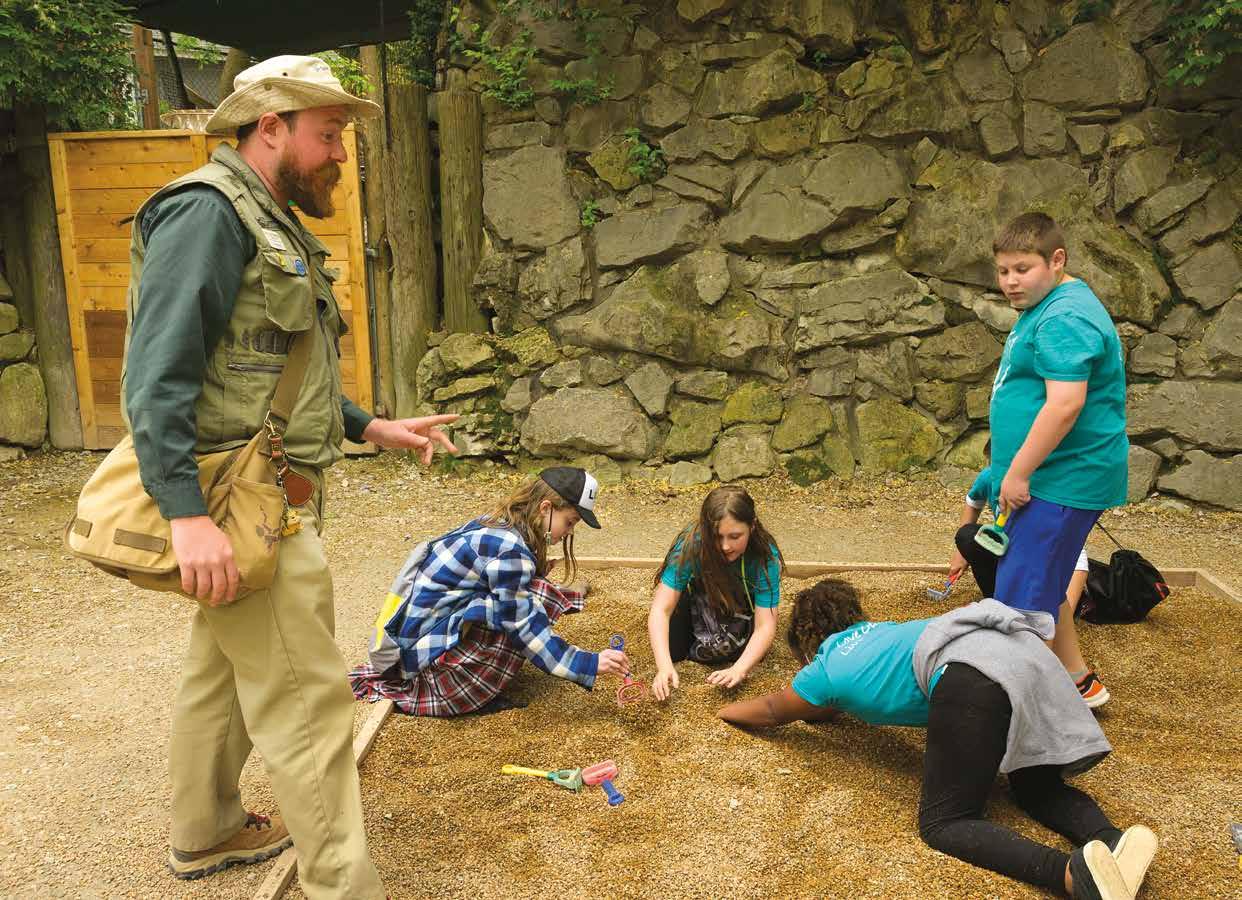
Interpreters, oversees a team of staff and volunteers who are expert storytellers and are stationed at various animal habitats across the Zoo.
“Through interpretation, we deepen people’s connections to animals through stories and conversation,” she said. “Kids usually come to us with a favorite animal, and we want to expand whatever their interests may be and enhance their Zoo experience.”
For kids who want to learn even more about animals, the Zoo offers educational programs throughout the year. Summer and fall programs are very popular (see the catalog of fall programs on pages 24 27), especially Camp KangaZoo, a summer camp program for kids in first through sixth grades. At Camp KangaZoo, campers learn about the natural world by observing Zoo animals and participating in tours, crafts and games. Activities like the “food chain game,” where kids pretend to be predators and prey, help kids to empathize with animals. Camp KangaZoo also includes a unique evening experience with a night hike around the Zoo.
“There’s something influential and memorable about having the Zoo all to yourself,” said Eve Cooney, Manager of Youth Programs. “We love making kids feel special.”
As with a shared philosophy that nature is the best classroom, Zoo educators mutually agree that it’s best for a child’s interest to guide their learning.
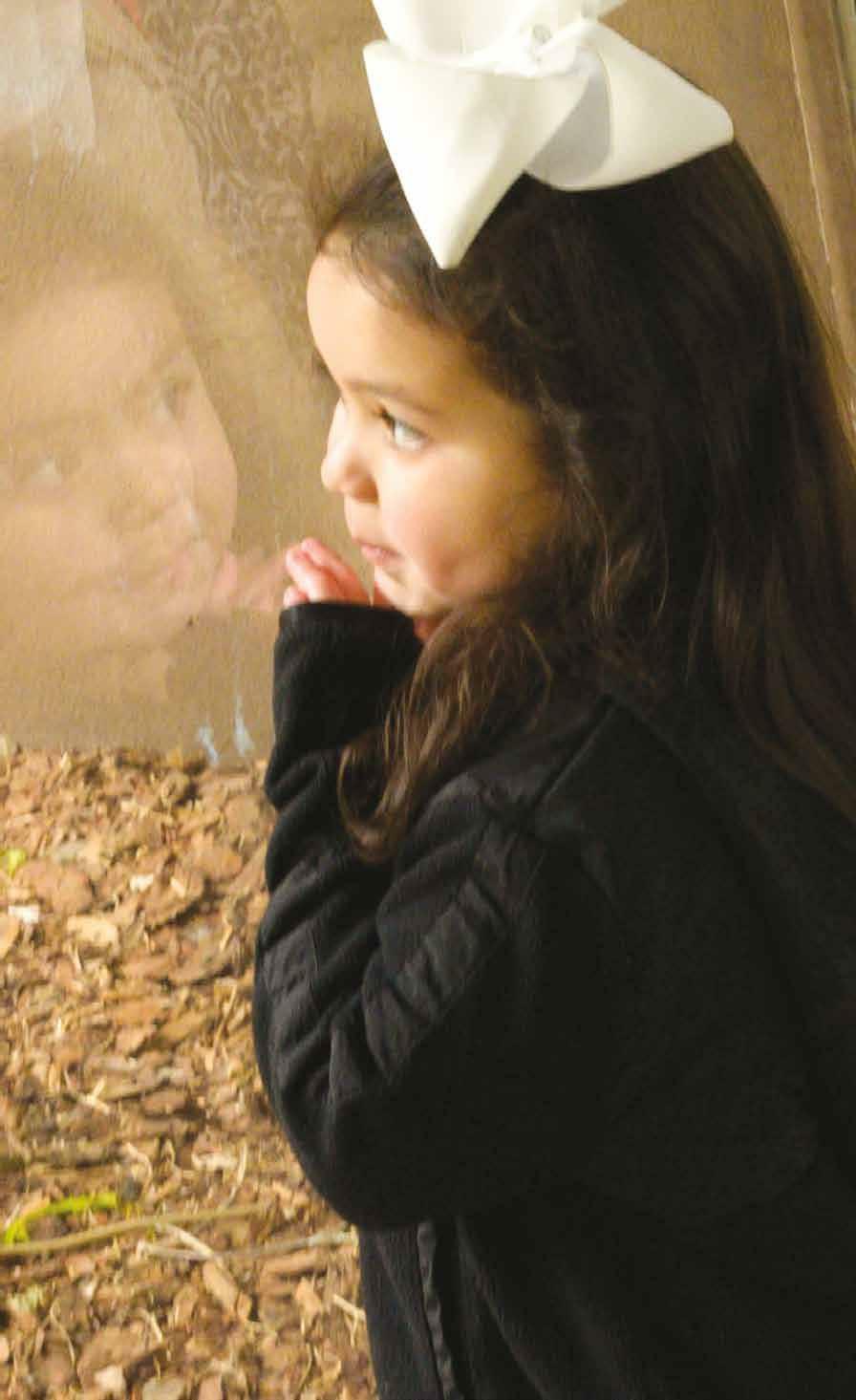
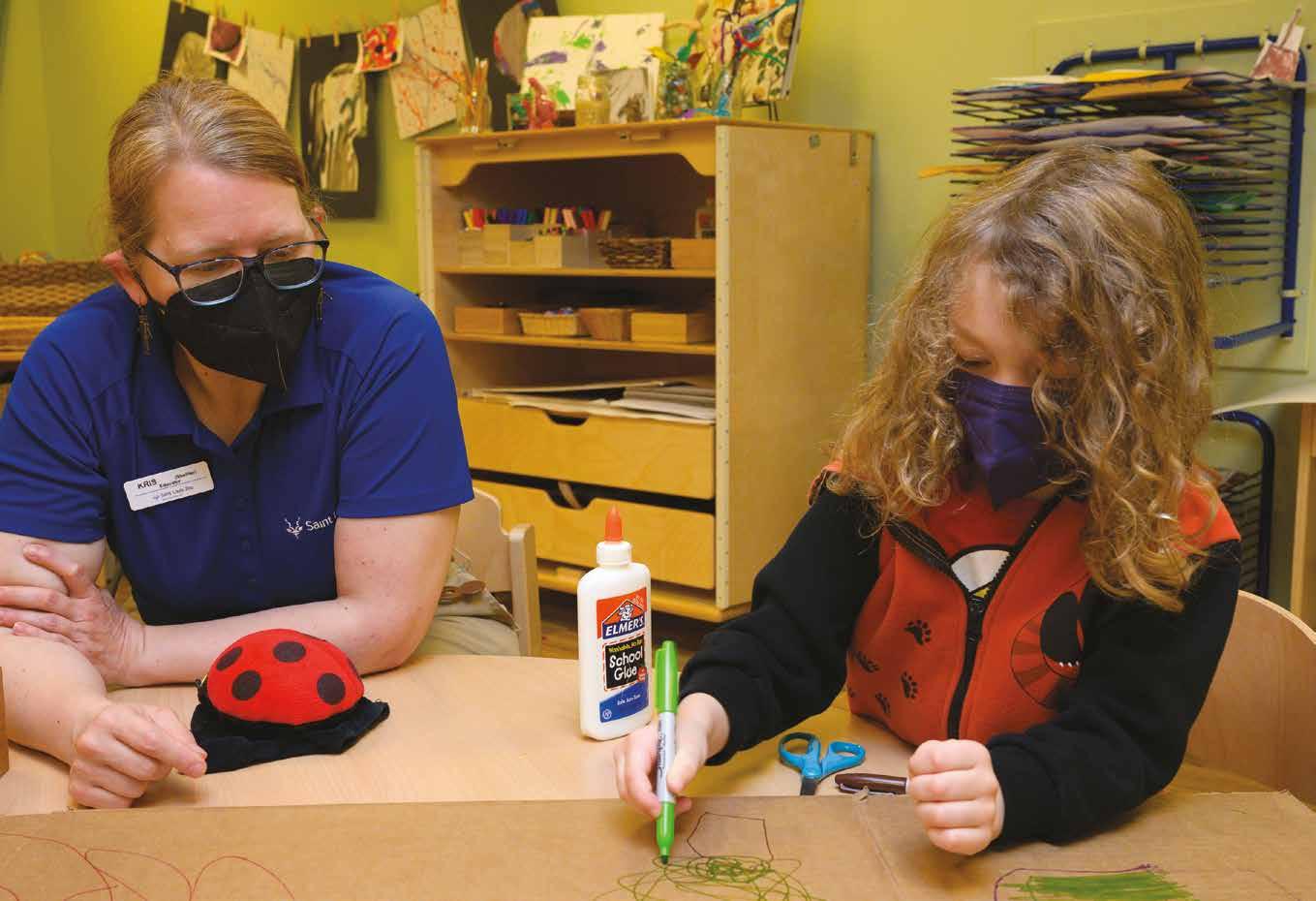
“We take cues from what the students are already interested in, and their interests guide our preschool classes,” Seger said. “Our 4- and 5-year-old class is interested in role-playing, so we are writing and creating a play. Children are likely to be more engaged and retain information if they first are interested in the subject matter.”
The same philosophy of child-directed learning applies to older kids, too. Kim Hoormann, Manager of Learning
Experiences, School Programs and Outreach, coordinates with K-12 teachers in St. Louis and around the world to bring in-person or virtual Zoo programs to those classrooms. She said she encourages kids to ask as many questions as possible so she and her team can gauge their interests.
“We like to meet students where they are at in their learning,” she said. “Maybe the class is just starting to learn about sustainability and how they can reduce waste in everyday life. Or, they may already know a lot about conserving resources and want to dig deeper into the topic. A program may go in a different direction, too, and that’s great! We get to learn together.”
zoo educators mutually agree that it’s best for a child’s interest to guide their learningLeft: Educator Kris Bruneau works with a student in Zoo Preschool on designing a prop for a play; Below: A young guest observes an animal at its habitat

Phillips distinctly remembers sitting in a classroom as a kid, watching an educational video about burning rainforests. At the end of the video, the narrator said to her class: Go save the rainforest. “Not only did we feel depressed, but we felt powerless as kids, how are we supposed to help a problem that’s happening miles away?” she said.
As she began her career, Phillips learned that the “gloom and doom” approach doesn’t work when it comes to communicating about conservation, especially among children.
“It’s important not to put the weight of the world on our kids,” she said. “When they get overwhelmed and scared, they mentally put up a wall. It’s also not their job to save us; sometimes people think the next generation will be the ones with solutions to solve our problems. We have the ability to save ourselves.”
An important part of any learning experience at the Zoo is discovering how to tangibly work toward a goal (conservation action), as problems without solutions tend to lead to apathy. Phillips said that telling a child to “save the rainforest” is too big and too far away, but giving them small tasks that they can do at home or in their community can ultimately help animals around the world. The St. Louis metropolitan area is especially full of opportunities for young children to help animals.
“We’re surrounded by streams and rivers, which lead to the ocean,” Phillips said. “By helping with litter cleanups, reducing plastic use and taking our Zoo’s #byetobags pledge, kids are helping ocean animals like sea lions. Kids naturally want to join something and be part of a bigger effort.”
Communicating about accessible conservation action is at the forefront for all Zoo educators, down to the signs shared at animal habitats. Conservation Education Liaison Emily Bowling is part of a team that helps ensure consistent, age-appropriate messages about animals and conservation are shared throughout the Zoo.
“When we were developing the Michael and Quirsis Riney Primate Canopy Trails exhibit, we made sure our
signs and activities at the exhibit were understood by and impactful for kids,” she said. “We tested all of these in advance of the exhibit opening it was awesome to hear the kids’ feedback!”
Bowling said each animal has a unique conservation action story, which you can find on exhibit signs and at activities, or a docent or interpreter will tell you a story. “At Primate Canopy Trails, our conservation message is about using products with sustainable palm oil or no palm oil, which helps primates’ rainforest homes,” she said. “When you visit Kali the polar bear, you’ll learn about climate change solutions. When you go see the stingrays or sea lions, you’ll learn about sustainable seafood and reducing plastic use.”
For the youngest children, like at Zoo Preschool, Seger said it’s about communicating the “why’s.”
“We use each side of paper, and we explain why,” she said. “We also compost after snack, use leftover drinking water for our plants and use cloth napkins ... and we explain to the kids why we do this and how it helps animals and our planet.”
Most of our Zoo educators’ favorite aspect of their jobs is how their work impacts children. Some of our educators, like Cooney, have worked at the Zoo for nearly 30 years. She often meets children through camp programs who go on to serve through the Zoo’s teen volunteer program she manages, Zoo ALIVE, and keep in touch as they grow up. In fact, Bowling used to be one of her teen campers!
“I’ve met kids at 6 years old and have kept in touch with them through their 20s; it’s the most rewarding part of my job,” she said. “I’m so proud knowing these kids are growing up with a conservation mindset. When they get to college or start a new job, some have started recycling programs or ‘green teams’ to discuss how they can make their organization an eco-friendlier place. By reaching kids at the Zoo, we’re building a foundation for the next generation of conservationists, and that’s why we love what we do.” n
Conservation action often starts at home, and our educators noted several ways parents or caregivers can help connect children to animals and nature


Let your child be curious. Ask open-ended questions: Why do you think that animal is doing that? Why do you think those plants are growing that way?
Do things around the house that help animals, like putting up a bird feeder or putting suncatchers in the window so birds don’t fly into them.
Be open-minded and let your child form their own opinions; for instance, if you’re afraid of spiders, try not to let your fears impact your child’s opinion.
Encourage your child to respect animals and lead by example (e.g., relocate insects instead of squishing them).
by
zoo,
reaching kids at the
we’re building a foundation for the next generation of conservationistsAbove: A Zoo Preschool student creates a costume in class and admires a photo taken by Educator Kris Bruneau; Below: Interpreter Jeannie Gearin instructs students on how to use pond nets
The Mary Ann Lee Conservation Carousel is an attraction that brings out the kid in all of us. Beyond the ride, there may be some things you didn’t know about the incredible work behind the Conservation Carousel.
The Conservation Carousel opened in May 2003 and has delighted over 6 million guests since that time. The ride features 64 hand-carved wooden animals, most of which have real-life counterparts found at the Zoo. Thousands of children and adults ride the Conservation Carousel every year, which causes some wear and tear on the wooden animals. The repairs and touch-up paint needed take a considerable amount of time, energy and meticulous detail. These tasks are done by Jeff Jones and Patrick Weck from Facilities Management’s Special Construction Team at the Zoo. This team handles tasks like creating model dinosaur fossils and play equipment in Emerson Dinoroarus, crafting different exhibit features like artificial rocks and stumps,
and building animal enrichment items like toys for the sea lions.
Before starting his career at the Zoo in 2020, Weck was an independent contractor for eight years and was hired by the Zoo to paint several murals inside the Charles H. Hoessle Herpetarium, the Primate House and the Bird House. His artistic career was greatly inspired by his mother, who is a ceramic artist. In addition, Weck’s father is a biologist, so when the job to paint murals at the Herpetarium came up, it was a perfect fit. When he and Jones were tasked to repaint and restore the Conservation Carousel animals as well, it seemed a great challenge.
“I think it was a happy accident,” Weck said. “Zoo management had seen my work, and I think they thought with Jeff and I together, we could get this done.”
In addition to the carousel restorations, Jones has 28 years’ experience working on Zoo exhibits and attractions. He has been part of almost every habitat renovation

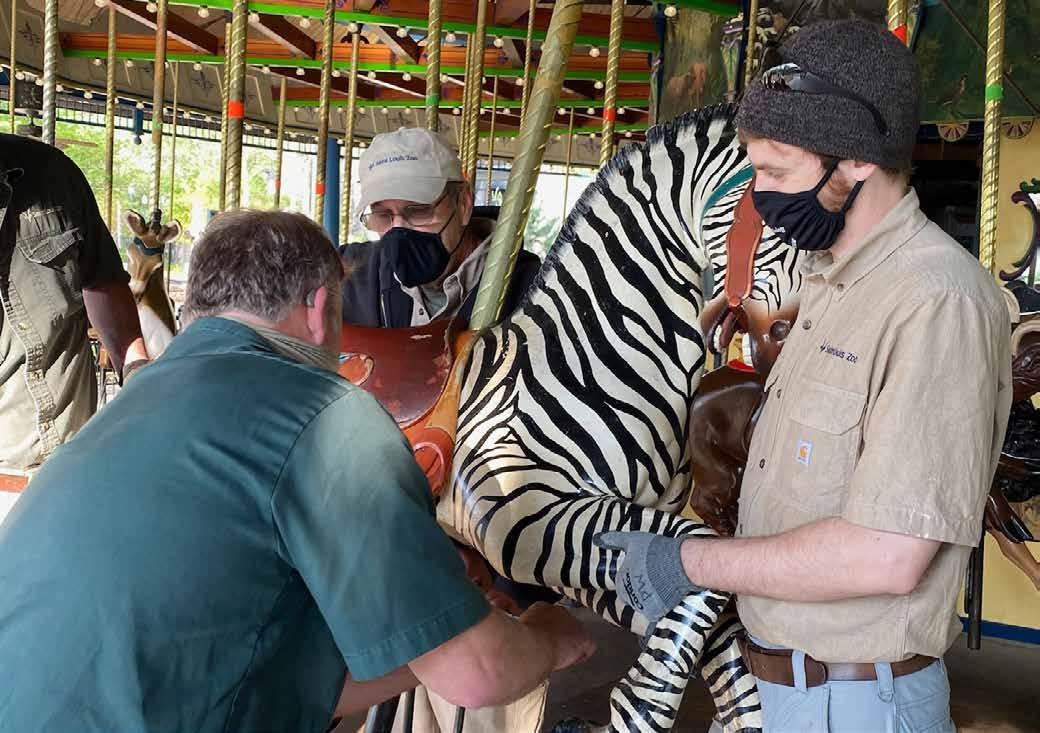
within the Zoo, including the Bayer Insectarium, River’s Edge, Penguin & Puffin Coast and the Donn and Marilyn Lipton Fragile Forest. Jones agreed that it’s been a rewarding experience to restore something that’s beloved by many people.
“Over the years of working at the Zoo, I have worked on a lot of different projects,” Jones said. “The biggest reward is to see the kids get so excited about something that I had the privilege to create.”
Weck and Jones take carousel animals back to the Zoo’s workshop to sand down any paint and use “body putty” to repair any dents on the animals. They use special sealant that is UV and weather-resistant, which prevents abrasion and will keep the quality of the animals much longer. Half of the Conservation Carousel animals were repainted in 2021, and the rest will be finished in 2023. With the right amount of time and attention, Weck and Jones make the wooden animals look good
as new. The team takes four animals at a time to repaint. Each animal takes about one week to repair.
“Over time we have gotten faster with it,” Weck stated. “Some animals need minor touch-ups while others need total revamping.”
This duo’s work on the Conservation Carousel will help the Zoo continue its mission to help animals here and around the world.
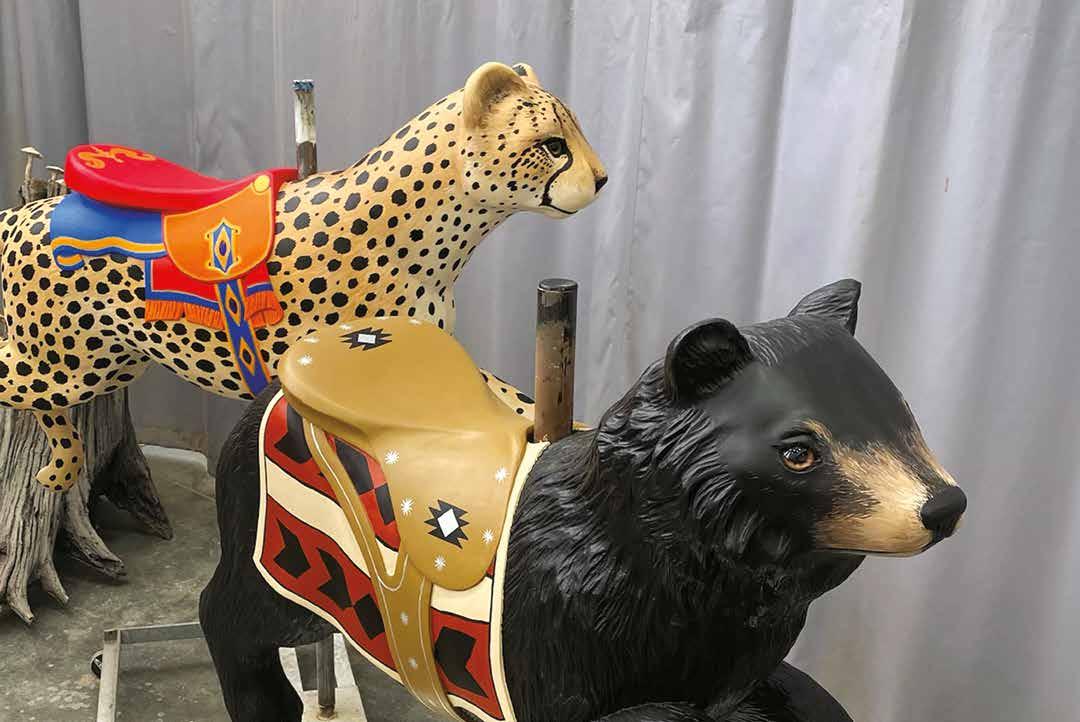
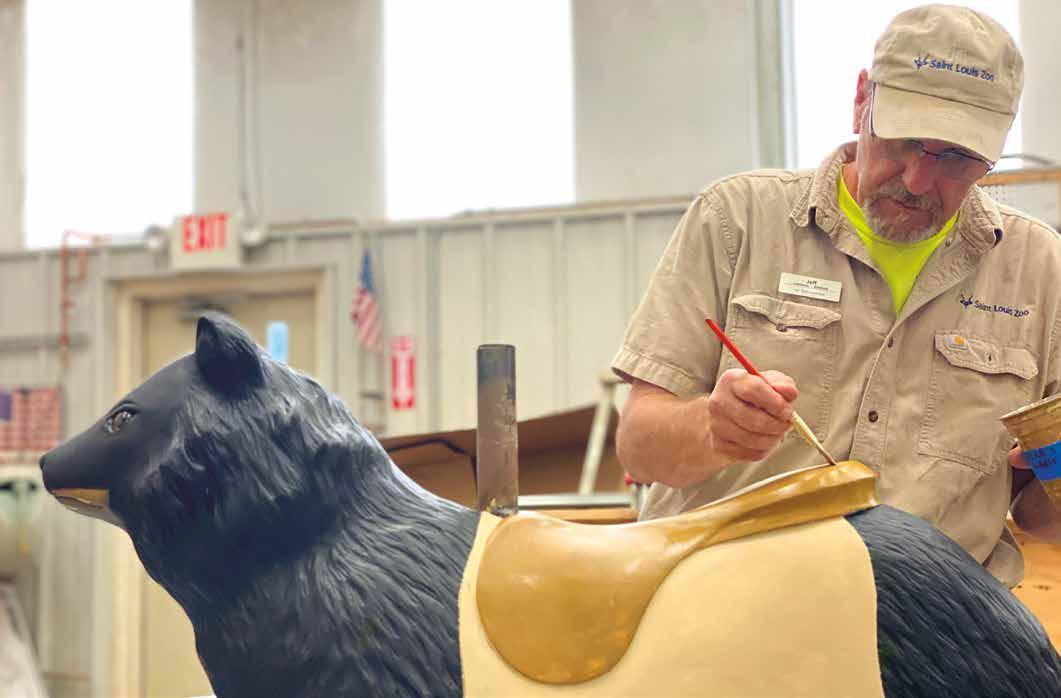
“The carousel is fun for families, but it also helps the Zoo’s conservation efforts … I’m proud to be part of preserving it,” Jones said.
When guests pay to ride, all ticket proceeds go to the Saint Louis Zoo WildCare Institute — the wildlife conservation arm of the Zoo — to support conservation efforts. Since its opening, the Conservation Carousel has raised $9 million to help animals and communities that are the most vulnerable.
From hours of repainting to the millions of dollars raised to support conservation, this classic
attraction is keeping living animals, as well as non-living carousel animals, around for future generations to
enjoy. While a single ride lasts just a few minutes, the memories and impact last a lifetime. n
The Conservation Carousel couldn’t have been made possible without the generosity of Mary Ann Lee and many other donors. Mary Ann was involved at the Saint Louis Zoo for nearly 30 years, both as a Marlin Perkins Society member and through her support of numerous projects.
Mary Ann wanted to make a gift that would bring joy to children and their families, as well as benefit animals and conservation. A gift to name the carousel was the perfect fit, and the Mary Ann Lee Conservation Carousel came to life in the spring of 2003.
Mary Ann’s enthusiasm for the project was incredible, and as a mother and grandmother, she appreciated the enduring qualities of a child-focused project. She also voiced that she wanted all children to have the opportunity to ride the carousel, so the Zoo worked with community organizations to distribute 10,000 free tickets during the carousel’s first year of operation.
Mary Ann Lee passed away on April 17, 2017. Thanks to her support and vision, millions have enjoyed a whirl on this beautiful feature of the Zoo, and she will always be remembered for her love of children and animals.
The Saint Louis Zoo WildCare Institute, the conservation arm of the Saint Louis Zoo, works to help animals and communities around the world. An important aspect of conserving animals is reaching the human populations that coexist with them. The WildCare Institute team, made up of animal care experts and educators, partner with communities and provide educational programs and resources, which in turn help animals.
Connecting Students to Nature in Forest Park Forest Park is a great place to get outside and enjoy nature. Today, many kids don’t have enough opportunities to get outside and explore. To help with this, the WildCare Institute Center for Conservation in Forest Park has partnered with The School District of University City, a school district just northwest of the Zoo, to help students connect with nature. These outreach efforts were placed on hold for a while due to COVID-19, but we were able to resume in fall 2021. I (Ben) was proud to lead 12 sessions with students.
Each year, third and fourth graders in the district get a chance to explore Deer Lake and the surrounding prairie. It’s a joy listening to and watching tadpoles, frogs and toads. The students are equipped with butterfly nets and bug catchers so they can safely collect pollinators. Most students are uncomfortable around bees at first, but once they see how they can
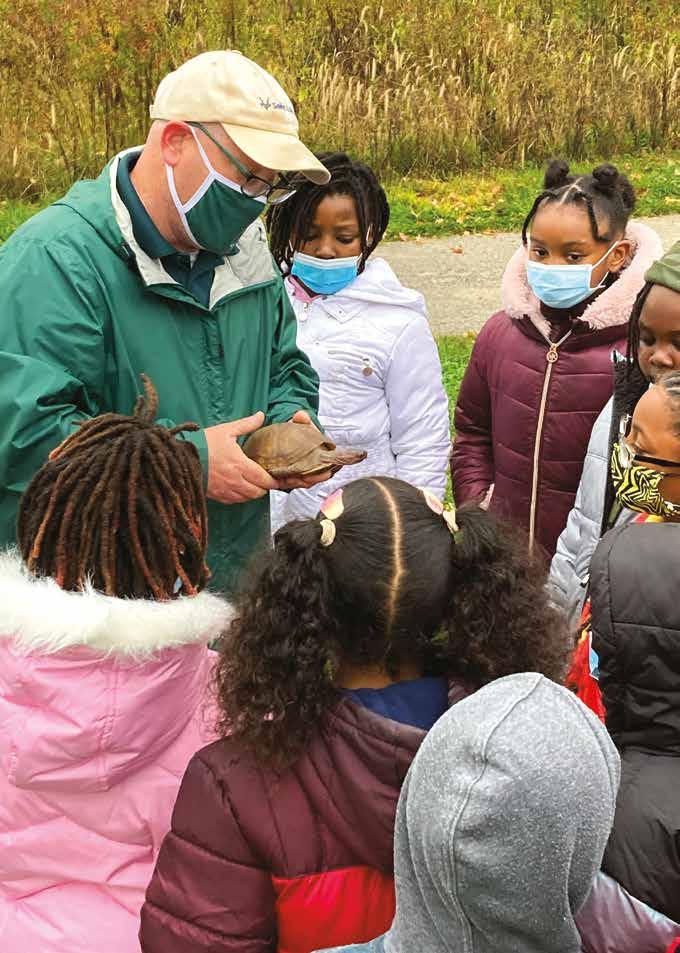
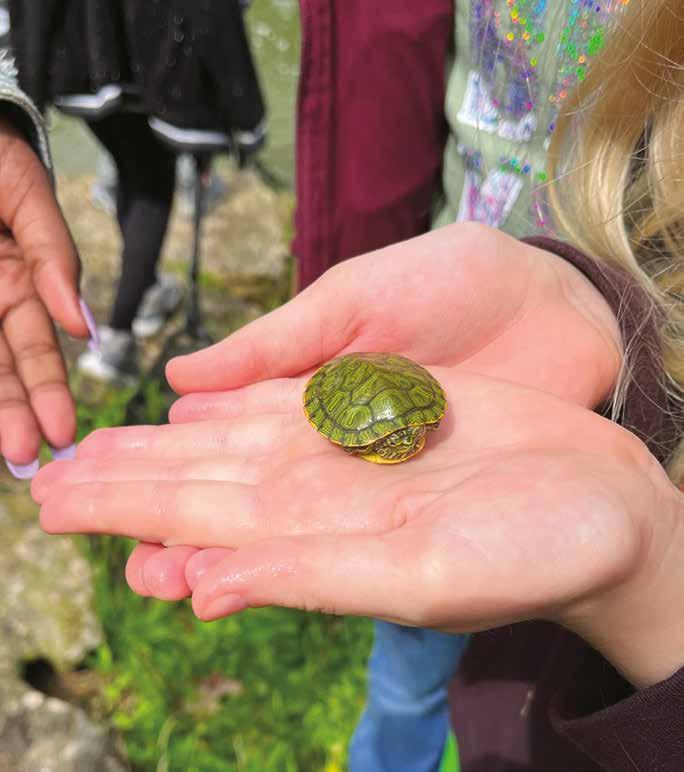
safely collect them and get an up-close look, their appreciation grows. Students also enjoy using binoculars to get a close view of birds. On most trips, they see ducks searching for food, egrets trying for a catch or red-tailed hawks eating their morning meal.

It’s difficult to keep 25 kids quiet while outside, but really, what’s the point? Just getting kids outside and exploring is the point. For most of these students, Forest Park is in their own backyard, but not all utilize it. I hope trips to this incredible park will foster an appreciation for nature and animals in the students, or at the very least, an appreciation for the world around them.
Invasive species (or non-native species) can harm other animals in the ecosystem. Accidentally introduced on Guam after World War II, the invasive brown tree snake devastated the island’s forest bird species. The local Division of Fish and Wildlife (DFW) developed a conservation plan to translocate (or move) native birds to remote islands as a bioreserve and as protection from brown tree snakes. DFW requested help from the Saint Louis Zoo WildCare Institute Center for Avian Conservation in the Pacific Islands, and we joined the conservation efforts. This group effort — consisting of Zoo staff and staff
from partnering organizations — is called Pacific Bird Conservation (PBC), and I (Tiffany) was thrilled to join the team this year. Since 2018, Zoo educators have participated with PBC to build public awareness about native bird conservation as well as build relationships with local conservation organizations in Saipan. This year, we focused on providing a variety of programming, including virtual programs and in-person options, at libraries, schools and at the field site. We also hosted professional development for 18 teachers. Many students are surprised that most birds living on Saipan aren’t found anywhere else in the world. The students learned about the important ecological role of their forest birds; they eat native fruit and poop out the seeds, which then germinate faster to help the forest grow.
Our goal ultimately is to inspire future conservationists. We reached over 500 students this year through our travels to the Micronesian Islands, and I believe we made a very positive impact.
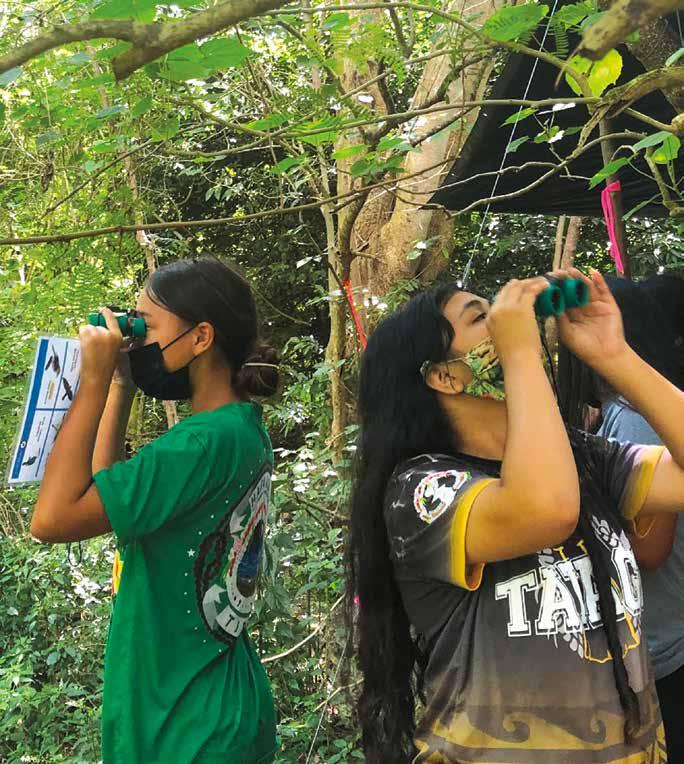
In 2013, the Zoo set out to facilitate groundbreaking exhibit interpretation at McDonnell Polar Bear Point by inviting indigenous voices to lead and develop the exhibit messaging. This effort yielded close partnerships with five Alaska Native villages and the King Island Native community. Our collaboration has the shared goal of engaging Zoo audiences in a respectful, positive and productive dialogue about climate change. The impact of this approach is enhanced by the fact that Alaska Native communities have extensive, direct and relevant experience not only with polar bears, but also with the impacts of a changing climate.
Through First Voices interpretation, a technique developed by colleagues at the Smithsonian’s National Museum of the American Indian, our Alaska Native partners are the lead voice at Polar Bear Point through themed, documentarystyle video journals created by middle and high school students in our partner villages. An essential element of these
partnerships is honoring the request made by our Alaska Native partners to provide educational opportunities for village youth. Since 2014, through the WildCare Institute Arctic Program, we have provided educational opportunities for the students and teachers in each of our partner villages.

When we are able travel to the villages, we provide interactive programs that focus on communitybased conservation, field science and non-Arctic wildlife species. I (Lisa) have traveled to Alaska six times, and it’s a phenomenal experience. We also offer free video-conference programming to remain as connected as possible. These educational programs also allow the opportunity to keep an ongoing connection between Kali (the polar bear at the Zoo) and the people in the village who rescued him. We regularly connect Kali live to the students in Point Lay, Alaska, so they can see him and talk to his keepers.
This is an incredible collaboration that signifies the importance of teamwork in making a difference for animals and the planet. n
July 14, 2022
Have a thrilling time at Shark Day! Come dressed as a shark and receive free admission to Stingrays at Caribbean Cove presented by SSM Health. Enjoy live entertainment and special kids’ activities. Free.
Night at the Zoo presented by Mercy
July 27, 2022; 5 – 8:30 p.m.
Chill out at an evening at the Zoo — perfect for a date night! As you roam around, enjoy music from a DJ and sip some spirits; two drink tickets are included in admission. And be sure to check out the Mary Ann Lee Conservation Carousel, Stingrays at Caribbean Cove presented by SSM Health and the Emerson Zooline Railroad. Sponsored by Mercy, Coca-Cola, Mid America Chevy Dealers and Urban Chestnut Brewing Company. Ages 21+ only. Zoo members: $25. Non-members: $30.
ZYP members may use their free tickets. More information: (314) 646-4771, option 2.
Jungle Boogie presented by Mid America Chevy Dealers
Fridays through August 12, 2022; 4 – 7 p.m.

Bring the whole family for an evening concert in the center of the Zoo. Sponsored by Mid America Chevy Dealers, Coca-Cola and Prairie Farms Dairy. Free.
Sea Lion Show
Through August 14, 2022; Daily, 11 a.m., 1 and 3 p.m.
Sea lion superstars will thrill you with jumps and lots of splashing! Shows will be held at the Lichtenstein Sea Lion Arena, which features an 811-seat amphitheater for seasonal shows. Zoo members: Included in member/premium member tickets. Non-members: $3.95/person. Children under age 2 are free.
 California sea lion
California sea lion
Regular Hours: August 15 – September 2, September 6 – October 12 9 a.m. 5 p.m.
Zoo closes at 4:30 p.m. on July 27 and August 24.
Summer Hours: Through August 14
and Saturdays, and from 8 a.m. to 5 p.m. on Sundays through Thursdays.
Jammin’ at the Zoo
August 24, 2022; 6 – 10 p.m.

The Zoo Young Professionals host a summer party that includes live entertainment and wine and beer tastings. Sponsored by Coca-Cola, Mid America Chevy Dealers and Urban Chestnut Brewing Company. Ages 21+ only. ZYP members may use their free tickets. Visit stlzoo.org for admission fees.
gentle ocean creatures. included in premium member tickets. Admission: $3.95/person. Children under age 2 are free. Feeding is $1. Group rate for 15 or more is $3 per person.
Dinoroarus features prehistoric creatures plus Dino Play and Dino Dig areas. Sponsored by Emerson and The Goddard School. Zoo members: Included in member/premium member tickets. Non-members: $5.95/person; free for children under age 2.
On Sundays through Thursdays, the Zoo is open from 8 a.m. to 5 p.m. On Fridays and Saturdays, and on Labor Day Weekend (September 3-5), the Zoo is open from 8 a.m. to 7 p.m.
Please visit stlzoo.org for the latest information about Zoo hours and events.

Children must be accompanied by an adult. Fees are listed PER CHILD.
These programs are designed for you and your child to explore the animal world together. Programs are hands-on and may include crafts, live animals, songs, stories, role-playing and more.
NOTE: All Early Childhood Education Programs are designed for caregivers to interact with and help facilitate the learning of the registered program participant. In order to best serve all of our Early Childhood participants, unregistered children may not participate in the programs.
FOR CHILDREN AGES 6–12 MONTHS
Lumpy, Bumpy, Fuzzy, Furry
What has bumps, what has lumps, what is fuzzy and furry? Join us for a tactile exploration of animal coverings.
C1112LB – November 12 (Sa); 9-10 a.m. Limited to 12 children
Please limit to one adult attending per child Fee: Zoo Members $22/General Public $25
FOR CHILDREN AGES 12–24 MONTHS
Dive into the wonderful world of these beautiful black and white birds. We’ll discover what they eat, how they move, and more about these amazing creatures.
C1211PP – December 11 (Su); 9-10 a.m. Limited to 12 children
Please limit to one adult attending per child Fee: Zoo Members $22/General Public $25
FOR CHILDREN AGES 2–3
Hiss, Growl & Squawk Roar like a lion and chatter like a chimp while exploring how animals communicate.
C0911HG – September 11 (Su); 9-10 a.m. Limited to 12 children
Please limit to one adult attending per child Fee: Zoo Members $22/General Public $25
Awesome Owls
Silently fly into the wild world of owls, where we will create our own zoo owl habitats, make owl art, learn the calls of our native owl friends and more.
C0218AO – February 18 (Sa); 9-10 a.m.
Limited to 12 children
Please limit to one adult attending per child Fee: Zoo Members $22/General Public $25
FOR CHILDREN AGES 3–5
Animals After Dark (Saint Louis Zoo WildCare Park)
Have you ever wondered what animals do after dark? Come explore which animals are awake all night and what they are up to. Together we will explore the Saint Louis Zoo WildCare Park and look for some nocturnal animals!
C1016AD – October 16 (Su); 5:30-7 p.m.
Limited to 14 children
Please limit to one adult attending per child Fee: Zoo Members $23/General Public $26
Sssnakes
Slither with us into the wonderfully weird world of snakes.
C0121SN – January 21 (Sa); 9-10 a.m.
Limited to 14 children
Please limit to one adult attending per child Fee: Zoo Members $22/General Public $25
Youth attend these programs on their own, unaccompanied by a parent or other adult.
SCHOOL BREAK CAMPS FOR STUDENTS IN GRADES 1–5
When school is on break, you can spend the day at the Saint Louis Zoo! Join our educators to learn about animals and conservation. Each day of camp will have crafts, games, Zoo tours and a whole lot of FUN!
Black Friday Camp: Black and White Animals
This day at camp will concentrate on black and white animals and how their color patterns help them in the wild. Campers will play games, make crafts and tour Zoo grounds to learn all about some of our black and white animal residents. Add Before and/or After-Care for an additional fee.
Y1125BC – November 25 (F); 8:30 a.m. – 4 p.m.
Limited to 16 participants
Fee: Zoo Members $55/General Public $60
Black Friday Camp Before-Care Participants can enjoy a continental breakfast (cereal, fruit, milk, juice) and indoor activities until camp begins. This program is for Black Friday Camp participants only.
Y1125AM – November 25 (F); 7-8:30 a.m.
Limited to 16 participants
Fee: Zoo Members $7/General Public $8
Black Friday Camp After-Care
Participants will enjoy a Zoo tour followed by indoor activities building on their camp experience. This program is for Black Friday Camp participants only.
Y1125PM – November 25 (F); 4-6 p.m.
Limited to 16 participants
Fee: Zoo Members $17/General Public $19
Winter Break Camp: Animal Acrobatics Whether it flies, crawls, slithers, swings, or swims, animals move around in incredible ways! Campers will spend this week playing fun games, making crafts, touring the Zoo and moving like the animals do. Join us for a week of hops, skips and jumps around the Zoo. Add Before and/or After-Care for an additional fee.
Y1226WC – December 26-30 (M-F); 8:30 a.m. – 4 p.m.
Limited to 16 participants Fee: Zoo Members $275/General Public $300
Winter Break Camp Before-Care Participants can enjoy a continental breakfast (cereal, fruit, milk, juice) and indoor activities until camp begins. This program is for Winter Break Camp participants only.
Y1226AM – December 26-30 (M-F); 7-8:30 a.m.
Limited to 16 participants
Fee: Zoo Members $35/General Public $40
Winter Break Camp After-Care
Participants will visit an area of the Zoo each day followed by indoor activities building on their camp experience. This program is for Winter Break Camp participants only.
Y1226PM – December 26-30 (M-F); 4-6 p.m.
Limited to 16 participants
Fee: Zoo Members $85/General Public $95
Martin Luther King Jr. Day Camp: Animal Adventure From the grasslands to the trees, from the desert to the seas, animals have amazing adaptations to help them survive! Campers will adventure around the Zoo, discovering how animals live in habitats all around the world. Add Before and/or After-Care for an additional fee.
Y0116MC – January 16 (M); 8:30 a.m. – 4 p.m.
Limited to 16 participants
Fee: Zoo Members $55/General Public $60
Martin Luther King Jr. Day Camp Before-Care
Participants can enjoy a continental breakfast (cereal, fruit, milk, juice) and indoor activities until camp begins. This program is for MLK Day Camp participants only.
Y0116AM – January 16 (M); 7-8:30 a.m.
Limited to 16 participants
Fee: Zoo Members $7/General Public $8

Participants will enjoy a Zoo tour followed by indoor activities building on their camp experience. This program is for MLK Day Camp participants only.
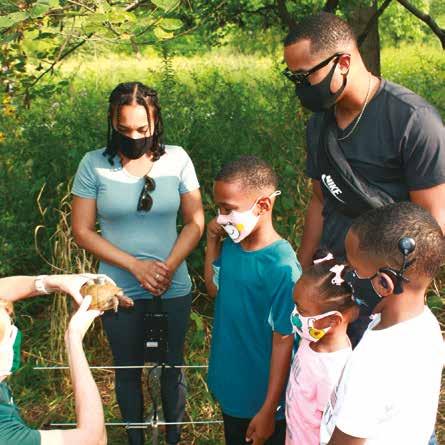
Y0116PM – January 16 (M); 4-6 p.m.
Limited to 16 participants Fee: Zoo Members $17/General Public $19
The Education Department offers many opportunities for scouts and other organized youth groups to enjoy the Zoo and learn about the animal world. Programs may include biofacts, activities, games, tours or crafts. We offer a variety of programs that help scouts work towards their badge requirements! Your group will have fun together while learning about animals, their habitats and conserving natural resources.
Visit the website for the scout registration packet. For more information, contact the Overnight Staff at overnights@stlzoo.org.
The Saint Louis Zoo is home to some incredible endotherms (or “warm-blooded” animals)! Some endotherms have feathers, while others have fur, but all of them are able to control their own body temperatures. This means that they can survive in some pretty extreme habitats. Come discover the birds and mammals that live at the Zoo, and how being warm and fuzzy helps them to survive!
Overnight evening activities will include rotations through exciting activities, an evening snack and a night hike around Zoo grounds. The morning portion of the overnight adventure includes a continental breakfast, a morning stroll around Zoo grounds to see the animals wake up, a souvenir Zoo patch and glow-in-the-dark overnight cup!
For Girl Scout Brownies and their adult chaperones
November 4; 6:30 p.m. (F) – 8:30 a.m. (Sa) January 21; 6:30 p.m. (Sa) – 8:30 a.m. (Su) February 25; 6:30 p.m. (Sa) – 8:30 a.m. (Su) March 18; 6:30 p.m. (Sa) – 8:30 a.m. (Su) April 1; 6:30 p.m. (Sa) – 8:30 a.m. (Su) April 28; 6:30 p.m. (F) – 8:30 a.m. (Sa)
For Girl Scout Juniors and their adult chaperones
November 12; 6:30 p.m. (Sa) – 8:30 a.m. (Su) January 20; 6:30 p.m. (F) – 8:30 a.m. (Sa) February 17; 6:30 p.m. (F) – 8:30 a.m. (Sa) March 25; 6:30 p.m. (Sa) – 8:30 a.m. (Su) April 7; 6:30 p.m. (F) – 8:30 a.m. (Sa) April 21; 6:30 p.m. (F) – 8:30 a.m. (Sa)
For Cadettes and their adult chaperones November 11; 6:30 p.m. (F) – 8:30 a.m. (Sa) February 11; 6:30 p.m. (Sa) – 8:30 a.m. (Su) April 15; 6:30 p.m. (Sa) – 8:30 a.m. (Su)
For Cub Scouts and their adult chaperones November 18; 6:30 p.m. (F) – 8:30 a.m. (Sa) January 28; 6:30 p.m. (Sa) – 8:30 a.m. (Su) February 3; 6:30 p.m. (F) – 8:30 a.m. (Sa) March 10; 6:30 p.m. (F) – 8:30 a.m. (Sa) April 22; 6:30 p.m. (Sa) – 8:30 a.m. (Su)
For Mixed Troops and their adult chaperones
January 27; 6:30 p.m. (F) – 8:30 a.m. (Sa) March 4; 6:30 p.m. (Sa) – 8:30 a.m. (Su)
Limited to 40 participants per session Fee: $50 per participant
Private Group Overnight Programs
For organized scout, youth and school groups with participants ages 5 and up, you can schedule your own private group overnight on select evenings. Using the themes we are currently offering, we will tailor the program to meet your needs. Fees listed per person.
Polar Bear Plunge
Limited to 18 participants 12 participant minimum Fee: $75 per participant
Warm and Fuzzies
Limited to 40 participants 16 participant minimum Fee: $50 per participant
Parents and children attend these programs together. Fees are per person.

For families with children ages 5 and up. Join us for this amazing opportunity to sleep inside Polar Bear Point! We will explore the Zoo at night while learning about Arctic and Antarctic animals and their unique adaptations that allow them to live in the cold. We will end the night by laying out sleeping bags inside the underwater viewing building. You will awake with a view of the polar bear pool and hopefully with a view of Kali! The overnight includes an evening snack, a reusable cup and a continental breakfast in the morning.
N1202PB – December 2-3;
6:30 p.m. (F) – 8:30 a.m. (Sa)
N0318PB – March 18-19; 6:30 p.m. (Sa) – 8:30 a.m. (Su)
Limited to 18 participants Fee: Zoo Members $70/General Public $75
For families with children ages 5 and up. Limited to eight participants in the same family group. Remember, a minimum of one adult must accompany the group.
This program offers a unique experience for your family to join in on a conservation research project. You will meet a field biologist and assist them with radio tracking wild box turtles living in Forest Park. Your family will learn how to use a radio antenna to locate the turtle, assist in conducting an observational health exam and record other data needed for this study. Closed-toe shoes and long pants are required. Participants meet at a designated area in Forest Park.
Program Length: 90 minutes, offered May through October
Fee per family group: Zoo Members $100/General Public $120
Booking times available on select days, between 9 a.m. – 3 p.m.
Visit the website to complete a booking request form. For more information, call (314) 646-4544, option #6.
For families with children ages 8 and up. Limited to eight participants in the same family group. Remember, a minimum of one adult must accompany the group.
Make your Zoo visit even more memorable with a Safari Walking Tour! Tag along with our professional interpretive guides as they offer insight into the animal world with engaging stories, interesting facts and animal observations. This tour does not include touching live animals or access to non-public areas. Choose one of the following topics:
Back from the Brink Walking Safari
Meet us for a tour through River’s Edge as we focus on the challenges and successes of breeding endangered species.
Here, There and Everywhere: WildCare Walking Safari
Join us as we explore why and how the Zoo is a world leader in saving endangered species through the work of the Saint Louis Zoo WildCare Institute.
Walk on the Wild Side Safari
Join our guide as you trek through the wilderness, passing through Centene Grizzly Ridge, McDonnell Polar Bear Point and the Donn & Marilyn Lipton Fragile Forest. Discover the simple things you can do to help save animals!
Tour Length: 60 minutes
Fee per family group: Zoo Members
$60/General Public $65
Booking times available on select days, between 9 a.m. – 3 p.m.
Visit the website to complete a booking request form. For more information, call (314) 646-4544, option #6.
FOR

The Saint Louis Zoo is proud to be home to over 300 different kinds of birds. Join us for a hot breakfast, followed by a 3/4 mile birdwatching stroll to see native birds as well as those passing through on fall migration. The stroll will also include stops at the Bird House and the Cypress Swamp Exhibit in the historic 1904 Flight Cage. Saint Louis Zoo traces its origins to the 1904 World’s Fair, when the Smithsonian Institution commissioned the Flight Cage for the Louisiana Purchase Exposition. Program starts at Lakeside Cafe. I0924BB – September 24 (Sa); 8:30-10 a.m.
See the summer program listings to register Limited to 20 participants
Fee: Zoo Members $32/General Public $36
Escape the Zoo
To help the Zoo save animals from extinction, you must unlock the secrets of the Zoo through a team-building adventure! Race against time and other teams to complete your mission by solving a series of puzzles and finding clues hidden along the pathways. Use these clues to discover what the Zoo is all about! We have a new challenge this year and welcome any past participants. Build your team of up to 10 individuals, ages 18 and up.
A0808EZ – August 8 (M); 6:30-8 p.m.
A0913EZ – September 13 (Tu); 5:30-7 p.m.
See the summer program listings to register Limit to 10 participants per team
Fees are PER TEAM
Maximum of two teams per session
Fee: Zoo Members $140/General Public $150
(Saint Louis Zoo WildCare Park)
Did you know that spending time in nature is proven to have measurable benefits to your health? Come spend quality time discovering nature through gentle hikes, nature journaling, meditation and more. Each participant will receive their own journal to capture their nature reflective experiences. Program participants meet at the WildCare Park.
A1008H1 – October 8 (Sa); 9:30-11:30 a.m.
A1008H2 – October 8 (Sa); 1-3 p.m.
Limited to 15 participants per session
Fee: Zoo Members $32/General Public $36
Adults age 18 and up can schedule their own private group overnight on select evenings. Using the current themes, we will tailor the program to meet your needs. Fees listed are per person.
Join us for this amazing opportunity to sleep inside Polar Bear Point! You will talk with Zoo staff about how we help animals all over the world and then team up to solve a scavenger hunt. After a night hike, we will end the night by laying out sleeping bags inside the underwater viewing building. You will awake with a view of the polar bear pool and hopefully with a view of Kali! This overnight includes a catered dinner and continental breakfast.
Limited to 18 participants 12 participant minimum Fee: $80 per participant
Visit the website to complete a booking request form. For more information, please contact the
locally with box turtles to study their longterm movement and health by comparing ‘city’ versus ‘country’ turtles. The program includes an introductory classroom portion on Zoo grounds, then we will divide into small groups to go into Forest Park and, using radio telemetry equipment, find a box turtle in our study and record observational data for this project.
NOTE: Families must provide their own transportation around Forest Park to the study site. Everyone must wear appropriate clothing (long-pants) and closed-toe walking shoes.
H0909TT – September 9 (F); 1-3:30 p.m. Limited to 24 participants
Fee: Zoo Members $13/General Public $17
For families with children ages 7 and up. No exceptions will be made. Do you love getting surprise packages or new toys? Animals do too, and it’s healthy for them! At the Zoo we call it enrichment. Enrichment helps animals move around, use their senses and keep their brains busy! In our hands-on program, participants will learn what enrichment is, why the Zoo uses it and how enrichment is made. Families will have the opportunity to brainstorm and create their own small animal enrichment design! Let’s get creative!
H1007AE – October 7 (F); 1-3:30 p.m. Limited to 24 participants
Fee: Zoo Members $9/General Public $13
together. One parent/adult must attend with the child(ren). Fees are per person. Unregistered children (siblings and infants) may not attend the programs.
For families with children ages 5 and up. No exceptions will be made.
Would you like to try field biology, use scientific tools, and contribute to an ongoing conservation research project? If so, join us to learn about how the Zoo’s Institute for Conservation Medicine (ICM) is working
The Education Department is pleased to offer FREE webinars, supported by The Boeing Company, each Wednesday at 10 a.m. Central Time, Labor Day through Memorial Day. These presentations are targeted for teachers and students, but anyone is welcome to join (individuals, homeschool families, scout groups, etc.)
Please visit https://www.stlzoo.org/education/ conservationlearning/stlzooms for topics and descriptions, which will include an ideal grade range as well. Each presentation will last 20-30 minutes and online attendance is limited to 1000. Free registration is required. For more information, visit stlzoo.org or call (314) 646-4644, option #6.
REGISTRATION: Registrations must be received at least two weeks prior to the scheduled program date. Registration forms can be mailed or dropped off (no facsimiles accepted). Online registration available on our website. No unregistered children (siblings, infants, etc.) may attend. PARKING: Options include the Zoo’s parking lots for a fee, or free street parking throughout Forest Park for all in-person programs. PAYMENT: Complete payment is required at the time of registration. Credit cards, checks and Saint Louis Zoo Gift Cards are accepted. A separate check must be sent for each program. Check payments must be received at least three weeks prior to your program date(s). For those programs that are sold out, checks will be returned. If the balance on your Saint Louis Zoo Gift Card does not cover the cost of all your programs, you must include credit card information to cover the price difference. Use of the Saint Louis Zoo Gift Cards are subject to the Terms and Conditions listed on our website. CANCELLATIONS: A refund minus a processing fee will be issued for all cancellations received two weeks prior to the first day of the program in which you are registered ($25 for multiple day, and $8 for single day programs). Some programs are not eligible for a refund so please check your availability before registering. We reserve the right to cancel a program due to low enrollment (full refund will be issued). TRANSFERS: Two weeks’ notice and a processing fee are required to transfer ($25 for multiple day, and $8 for single day programs). IMPORTANT: To prevent the spread of COVID-19, additional restrictions will be required for attending all in-person programs. See the Terms and Conditions Section under the registration information for more details. YOUTH ATTENDEES: See the Zoo’s policy for escorting children under 14. LOCATION: Programs will be held at the Zoo or virtually via Zoom. CONFIRMATIONS: A Registration Report will be e-mailed after your registration is processed. If you prefer a mailed, paper confirmation, check the appropriate box on the registration form. Contact the Education Department at (314) 646-4544, option #6 for more information.
Claims Release I, on behalf of myself and my family, recognize and acknowledge the risk existing as participant(s) in a Saint Louis Zoo program or activity. I fully and unconditionally release the Saint Louis Zoo, all associates and/or assigns from any and all claims for personal injury and/or property damage. I voluntarily declare this release to be my full acknowledgement to relinquish all rights for any and all injury and/or property damage resulting from participation in Zoo programs or activities. Photos taken by the Saint Louis Zoo staff and volunteers during any program or activity are property of the Zoo and may be used for public relations purposes related to the Zoo. The following applies for In Person Programs: Although safety precautions as to your visit are taken by the Saint Louis Zoo, every visitor/program participant is responsible for his or her personal safety and that of children or others under their supervision. In consideration of access to the Zoo, visitors/program participants (a) agree to comply with Zoo policies and instructions, including those on signage (b) understand and agree that the novel coronavirus, COVID 19, has recently infected individuals in the St. Louis area, that it is contagious and that it can spread to persons in any number of ways (c) agree that they assume responsibility for any injury (including personal injury, disability or death), illness, damage, loss claim, liability, or expense arising out of or related to COVID 19 experienced or contracted in connection with a Zoo visit/program (d) that they waive and release all claims against the Zoo and its commissioners, officers, employees, volunteers and agents relative to the foregoing matters and (e) that they agree that the Zoo is legally entitled to sovereign immunity regarding to any such claims.
Medical Consent In case of emergency, I understand that every effort will be made to reach me, followed by the emergency contact. In the event that neither I, nor my emergency contact can be reached, I give my consent for my child to be taken to the nearest appropriate hospital for immediate care.
If participant (listed below) is 18 years or older, participant must Sign for themselves
OR if Participant (listed below) is under 18 years, Parent/Legal Guardian must Sign
Signature:
Participant's First and Last Name: Child Birth Date: Grade: Adult Birth Date:
Participant’s Relationship to Head of Household/Member above (son, daughter, etc): Check all boxes that apply to the participant. We may contact you for additional information.
List participant’s allergies: Food Allergies Other Allergies Are there any accommodations you would like to request for the participant? We will contact you if we are unable to meet your request. Please explain anything else you would like us to know.
speak conversational English
Will your child bring an EpiPen® or other epinephrine auto-injector? Yes No

If you selected “Yes,” you must complete the FARE form (Food Allergy and Anaphylaxis Emergency Care Plan). Will your child need to take medication during Zoo program hours? Yes No If you selected ‘Yes’, you must complete the Zoo’s medication form for prescribed and over the counter medications, which can be found on the Zoo’s website. Trained Zoo personnel will only administer medication in an emergency situation. Please specify all medications that your child will be using before or during the program. Emergency Contact Name: Phone(s):


The Saint Louis Zoo lost a dear friend and advocate for the Saint Louis Zoo Institute for Conservation Medicine (ICM) in June 2021 with the passing of Carol Gronau. Carol had a passion
for conservation and science. In 2015, Carol purchased an imaging system for the ICM molecular lab, which helped make infectious disease testing possible. It was during a visit to the lab that Carol decided to dedicate her time and talents as an ICM volunteer.
“We are so grateful to have known her,” reflected ICM Director Sharon Deem, DVM, Ph.D., DACZM. “Carol was a cherished member of our team and brought her editing skills to tasks such as editing fact sheets. She also helped organize thousands of photos and blood
slides, all the while asking questions about our projects and advocating for our work.”
Carol started volunteering at the Zoo in 1993 as a docent and was a Marlin Perkins Society member for 23 years. Her legacy working with the ICM team will continue, thanks to a generous gift to the Zoo Endowment for research and conservation medicine. Through this gift, her love of the Zoo, words, science and animals will live forever and will continue to inspire the entire Zoo community. n
Wells Fargo is a dedicated Saint Louis Zoo supporter and corporate member of the Marlin Perkins Society, making an invaluable philanthropic impact on the St. Louis region and greater conservation community.
In the early 2000s, Wells Fargo pledged to support the Zoo’s Gateway to the Animal World Campaign, a contribution now recognized along “Raja’s Trail” in River’s Edge. Wells Fargo also supported the construction of the Mary Ann Lee Conservation Carousel, which has been enjoyed by over 6 million riders since opening in 2003.

Wells Fargo then gave a generous gift to The Living Promise Campaign
to build the pedestrian bridge over Wells Drive, completed in 2010, which enhanced the experience of guests who arrived at the Zoo’s South Lot.

Wells Fargo has been the presenting sponsor of A Zoo Ado and ZOOFARI, the Zoo’s largest summer fundraisers, for 14 years. Proceeds from these events help the Saint Louis Zoo’s conservation efforts here and around the world.
Throughout the years, Wells Fargo has contributed to the financial well-being of the Zoo and provided their employees with the opportunity to see their contributions up-close through volunteerism across Zoo grounds.
Their employees also get the chance to experience Boo at the Zoo with their families each year through exclusive Wells Fargo nights.
The Saint Louis Zoo is incredibly grateful for Wells Fargo’s outstanding support throughout the years and looks forward to continuing our relationship for many years to come. n
The Saint Louis Zoo cares for animals in many ways, from ensuring animals have stimulating habitats and enrichment to providing comprehensive veterinary care. On the same note, there are countless unique ways to support our animal care work. Three donors — Lisa Mechele, De Kaplan and Estelle Siteman — have given generously to support the purchase of various medical and research equipment for the Saint Louis Zoo Endangered Species Research Center & Veterinary Hospital.
Lisa Mechele began her philanthropic journey with the Zoo when she realized that she wanted to be an active participant with her charitable giving. Lisa’s giving-whileliving approach allows her to witness the impact of her giving while kindling her love and knowledge of Africa and its endangered animals. Her gift to the Veterinary Hospital helped staff purchase an ultrasound machine and probes, special observation research workstations, and other necessary equipment for animal care, treatment, and reproduction research.
“I’ve visited Africa several times over the last 20 years,” Lisa said. “But the last few visits, I have noticed fewer and fewer of its incredible animal populations, which devastates me. I wanted to support an organization that would directly benefit them. The Saint Louis Zoo, with its local and international WildCare Institute Conservation Centers, fit perfectly. And I love that my gift could be used immediately to help the Zoo’s conservation efforts and to treat the animals that needed those machines!”
Estelle Siteman and De Kaplan had a similar revelatory moment during the pandemic. “It was the uncertainty during the pandemic that really hit home,” Estelle said. “As other parts of my life continued to change to a new normal, I wanted to help keep one thing static: the future care and protection of animals. The Zoo offered a perfect solution and allowed my family and me to ensure our future legacy would support animals both here and in the wild.”
Support from donors helped the Zoo purchase a new portable anesthesia machine as well as a multi-parameter anesthetic monitor for the Animal Health team


Additionally, Estelle encouraged her family to help care for the animals at the Zoo. A gift was received from the Siteman Family Charitable Fund, a component fund of the St. Louis Community Foundation, to support the Zoo’s purchase of a new portable anesthesia machine as well as a multiparameter anesthetic monitor for the Animal Health team.
“These gifts, and these donors, are just incredible!” said Chris Hanley, DVM, DACZM, Director of Animal Health at the Zoo. “To know that folks outside of our organization see the needs we have to provide our animals with the best possible care, and then actively support them, really moves me. These may not be the most glamorous opportunities for generosity, but they are critical for my staff and the animals here at the Zoo, especially as we expand to additional campuses.”
Designated gifts like these can often support important purchases, like our equipment to support animal health, and have an equally impressive impact on the Zoo and its mission of Animals Always. n
St. Louis lost an incredible leader in business and philanthropy with the passing of Michael Neidorff on April 7, 2022. As the CEO of Centene Corporation, Michael helped the company gift millions of dollars to institutions across the country, especially the Saint Louis Zoo.
“We lost a great leader, businessman, philanthropist, and personally, I lost a good friend in Michael,” reflected Jeffrey P. Bonner, Ph.D., President Emeritus of the Saint Louis Zoo. “At Michael’s request, we traveled to Botswana and South Africa together so that he could immerse himself in the wild wonders that our Zoo works so hard to protect and conserve. His generous gifts to the Zoo, both personal and through Centene, were always supported by his admiration for our work. I will always cherish those memories of sharing the natural beauties of Botswana and South Africa with him.”
Michael led Centene for more than 25 years, guiding the organization to expand its philanthropic reach nationally while also supporting local
St. Louis institutions. Centene’s most notable gift to the Zoo was to Centene Grizzly Ridge in 2017, a gift that reflected the mission of the Centene Charitable Foundation to improve the quality of life for families and their communities. The Foundation is a steadfast Marlin Perkins Society corporate member, and Centene has hosted its employee appreciation events at the Zoo for several years. Additionally, Michael was an esteemed member on the Saint Louis Zoo Association Board. Clearly, Michael’s passion for the Zoo carried over to his role at Centene, much to the pleasure of many of its employees who enjoyed their company connection to the Zoo.


Michael’s generosity to the Zoo increased with a personal gift from him and his family to name the Neidorff Family Carousel Plaza in 2017. This area is beloved by families and guests to the Zoo for its stunning up-close views of the Caribbean flamingos, access to Fragile Forest and McDonnell Polar Bear Point,
and of course, the magical Mary Ann Lee Conservation Carousel.
“Michael and Noémi Neidorff are incredible leaders in our community, and I am grateful to have had their support and friendship over the years,” said Cynthia S. Holter, Senior Vice President of External Relations at the Zoo. “One of my fondest memories of Mr. Neidorff was being on a golf cart with him and Noémi during an event at the Zoo for Centene employees and their families. There were nearly 10,000 guests there that day, and he waved to everyone he saw and knew so many by name. He even hopped off the cart to take family photos and enjoy some cotton candy. Everyone thanked him for sharing the Zoo, and it was a really special day for all of us.”
Michael leaves behind a legacy of charity, gratitude, passion, determination and trust that he had built amongst other St. Louis leaders and institutions. We will all feel the loss that his passing leaves in the history of St. Louis’s greatest leaders. n
The Saint Louis Zoo is extremely fortunate to have the support of more than 1,300 generous individuals, foundations and corporations through the Marlin Perkins Society. We welcome our newest members to the Society and thank them for joining this wonderful group of supporters. To our current members who have increased their financial support, we are pleased to recognize you as well. We are grateful for your commitment to our mission.
February 1 – April 30, 2022
American Metals Supply
B&N Inspection
Erin & Jason Beam
John & Penelope Biggs
Barry T. Cervantes
Justin & Danielle Colbert
GRP Wegman Co.
Joe, Tara, Noah & Grant Hahn
Hansen’s Tree Services & Environmental Resources Andrew, Erin, Zayne & Ryker Haskins Michael & Courtney Jordan
Tamara Keefe
The Kuhn Foundation
Scott MacArthur Dwight & Kathy Scott
Scout Realty Group Mark & Jennifer Stirnemann
Visionary Wealth Advisors
Terry Williams
Brenda & Tina Willis
February 1 – April 30, 2022
American Metals Supply
Mrs. Mary Randolph Ballinger (25)
Susan M. Barrett
Kevin & Debra Bastien
Dan Berglund & Dr. Suellen Greco
Jerico & Stephanie Collins
Mr. & Mrs. Paul Dalba Paul & Suzy Davis
Margaret & Gordon Finley
William T. Gamewell (10) Peter & Jennifer Goessling Elizabeth Green
Hauser Mechanical, Inc. Jen & Matt Heisel Family Milton Hieken & Barbara Barenholtz
The Hunter Family Foundation
Elizabeth & Austin Kent
Gary & Patricia Krosch (10) Bruce & Diana Linders (10)
Kenneth & Holly McGarrahan
Randy J. & Cathy M. Meisner
Mr. & Mrs. Jason Mills Steve & Karen Reese Rich & Louise Renner Fred & Emily Schrick Neal & Jayne Schroeder
In Memory of Patricia Swartz Bob & Sara Tehan
The Webb Family James & Dana Whalen (10)
Mr. & Mrs. James Woodworth (15)
(10) denotes member for at least 10 years (15) denotes member for at least 15 years (25) denotes member for at least 25 years
Please contact the Development Office at (314) 646-4859 if you:
• Would like information on how you can join or increase your support to the Marlin Perkins Society
• Discover a discrepancy or have a question (the Zoo makes every effort to acknowledge all gifts and to maintain accurate records)

The following list represents new gifts and pledges made to the Saint Louis Zoo Association from February 1 to April 30, 2022. Donors are listed in the category of their most recent giving to the Saint Louis Zoo.
$1,000,000 and above Kevin Beckmann Charitable Trust
The Dana Brown Charitable Trust, U.S. Bank, Trustee The David B. Lichtenstein Foundation
Major Gifts
$749,999 – $500,000 John & Penelope Biggs
$249,999 – $100,000
Richard & Katherine Lintz
$99,999 – $50,000 Estate of Darlene Damon

$24,999 – $10,000 Ms. Betty Beckmann Scott & JoAnn Decker
Mr. Charles J. Hess Kansas City Zoo
James R. & Mary C. Walters Woodland Park Zoo
$9,999 – $5,000
Bunge North America, Inc. Joyce & Mike Bytnar Delta Dental of Missouri
Joseph & Elizabeth Goellner III Ms. Susan Latorre
Leo R. Buder Foundation Trust Drs. Dan & Susan Luedke Anna & Jim McKelvey
Susan Perrin
Society for Information Management John & Ellen Wallace
$4,999 – $2,500
Stephen & Karen Baxter David & Cathryn Beisel Estate of Marcia Jane Kaden H. Smith & Janet McGehee Dr. Pamela M. Schuler Karen Strobach Ms. Tina VonderHaar
$2,499 – $1,000 Alaska Wildland Adventures Anonymous
Mr. & Mrs. Gregory C. Baxter
Maleen & James Corrigan George & Victoria Hubbell
Pavla & Daniel Landiss Janice R. Loudenslager Gordon & Cassandra Rashman
Penny Rohacek
Ellen Walz Svenson Mr. James Terry
$999 – $250
AAZK – St. Louis Chapter
Akron Zoological Park
Anonymous
Roger Clawitter & Ann Day
Creative Services – Saint Louis Zoo
Mike & Sue Darcy
Travis Dean
Carol & David Gast Family
Lisa & Eric Gorham
Dr. Ronald & Mrs. Ellen Gross Mr. Patrick J. Kleaver
Barbara Koenig
Jean & Leigh Mason
Mr. and Mrs. Sanford N. McDonnell Foundation
Metropolitan Zoological Park & Museum District
Anna Perinchery-Herman
Michael Schwartz & Joan Dykman
Nicole Shelledy & Greg Heinz
Katherine & Benjamin Simmons Emma Spong & Tom Mazuranic Kellie & Greg Wanko Ms. Kathy M. Wolf
The Saint Louis Zoo Development Office regrets any errors or omission of any gift.
If you would like to change your honor roll listing, contact Katie Meyers at meyers@stlzoo.org.
Donors providing the Saint Louis Zoo Tribute Fund with gifts of $25 or more between February 1 and April 30, 2022 to honor or memorialize events and loved ones include:

Barbara Becker
Mr. & Mrs. Charles Eisenkramer
Bill & Pam Fisher
Ms. Joan Glassman
Edward & Laura Greenberg
Carolyn Harte
Terry Liberman
Blythe Meisinger
Ms. Sally A. Pinckard
Mark & Annette Polzin
John & Cindy Sheehan
Stephanie Struckmeyer
Barb Takavitz
Ms. Marilyn Vollet
Lyn Anne Ballard
Class of 1971, North Greene High School
Jacksonville Public Library Charles S. & Sara E. Tavender
Michael Lyss & Carol Kaplan-Lyss
Trudy Aldridge
Mr. & Mrs. Gregory C. Baxter
Stephen & Karen Baxter
Mr. William E. Brush, Jr.
Roger Clawitter & Ann Day
Mrs. Donna Kniest
Ms. Susan Latorre
Ms. Kathy M. Lewis
Irv & Sharon Logan
Tracy & Joel Malke
Ms. Barbara M. Rebstock
Ms. Linda R. Reifschneider
Ms. Sally Reinholdt
Ms. Toni Schmidt
Bruce & Ann Schuette
Carl Swarz & Cathy Goldstein
Richard & Kim Thoma
John & Mary Jo Wich
Rosemary H. Holthaus
Savannah & Garin Holthaus
LaDonna L. Hopkins
Ms. Amy Bertchausen
Amy Loden
Lori A. Sullivan & G. Todd Rogan Lynn & Craig Trojahn
Robert E. Kleiger
Margaret M. Leaders
Jerry Kopp
Sally Blinder
Ms. Therese Glatzhofer
Ms. Molly Goldstein Stephen & Marjorie Herr
Bernard G. & Barbara Kohm
Scott Lasker
Gay Lipman
Marilyn Lipman
Ashley Loiterstein & Ann Loiterstein
Mr. & Mrs. Michael N. Newmark
Martha Powers
Daniel S. Ross
Ms. Laura Staley
Corey Warren
Mary Latta
Kristen Melchior
Kellye Markowski Steve Hrin
Cathryn Mollman
Mrs. Ann L. Case Ms. Linda R. Reifschneider
Seth Moore Robert & Anne Orth
Michael Neidorff
Dr. & Mrs. Sherman Silber
Shirley M. Newman Dave & Edna Lanahan
James O’Donnell
James L. & Lisa W. Nouss
Sandy Perkins
Mr. & Mrs. Jack Jones
Walter Ruch
Mr. & Mrs. Charles H. Hoessle
Edna L. Schoknecht
Ms. Betty S. Balzer
Keith J. Smith Bassett Healthcare
Wanda J. Stewart
Ms. Eleanor Hecht
Kathy Buchanan Linda & Simba White
Phyllis R. Tirmenstein
Mr. Jeffrey L. Huntington
Janet C. Walsh
Mr. & Mrs. Steven A. Schumm
In Honor Of Mr. & Mrs. Ted W. Beaty David Schafranka
Mrs. Penelope Biggs
Elizabeth Teasdale
Jeffrey P. Bonner
Frank & Martha Fischer
Mr. & Mrs. David P. Gast
Jean & Leigh Mason John & Ellen Wallace
Susan H. Corley
Maleen & James Corrigan
Daniel & Hillary Elfenbein
Lori A. Sullivan & G. Todd Rogan
Jackson Hunziger
Theresa A. Hunziker
The best lunches are ones that are healthy, tasty and don’t make a lot of trash. Trash is the stuff we throw in the trash can and it goes to a landfill. It can’t be reused or recycled into new things. Swap the lunch trash on the left with a sustainable item on the right! Draw a line to the item that is the best match. Keep this guide handy when packing your lunches this upcoming school year!
Bottle: Reusable Water Bottle; Paper Napkin: Cloth Napkin; Plastic Sandwich Bag: Reusable Container.
Answers: Paper Bag: Reusable Lunch Box; Fruit in a Plastic Tub: Banana, Orange or Apple; Single-Use Plastic
